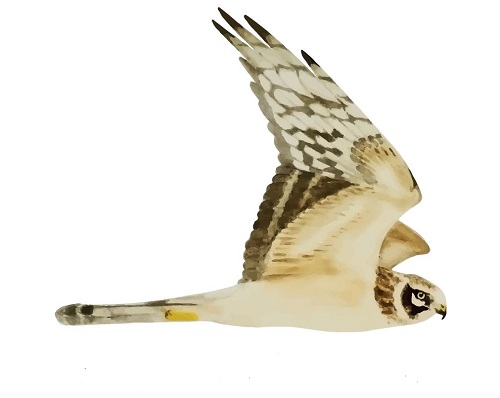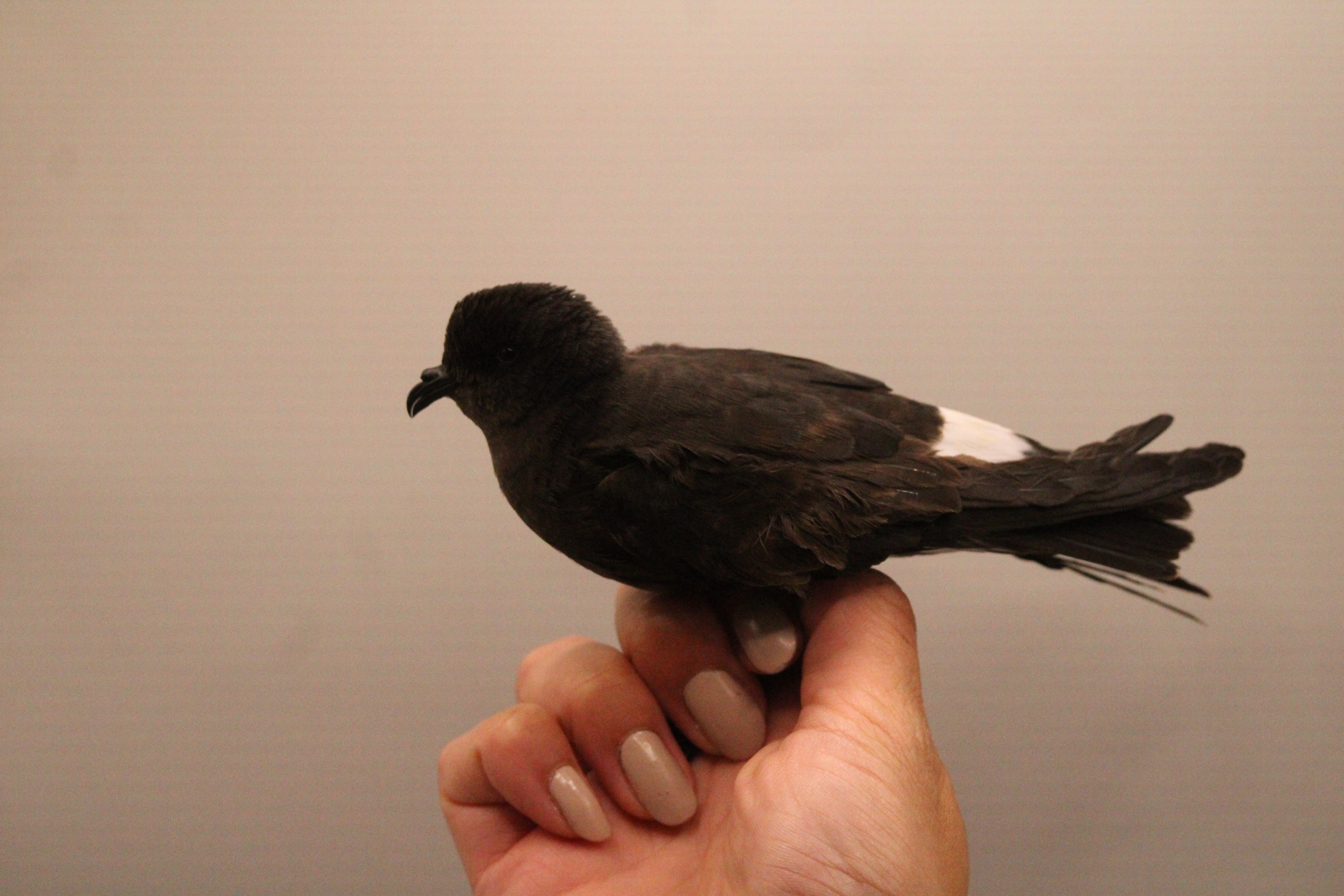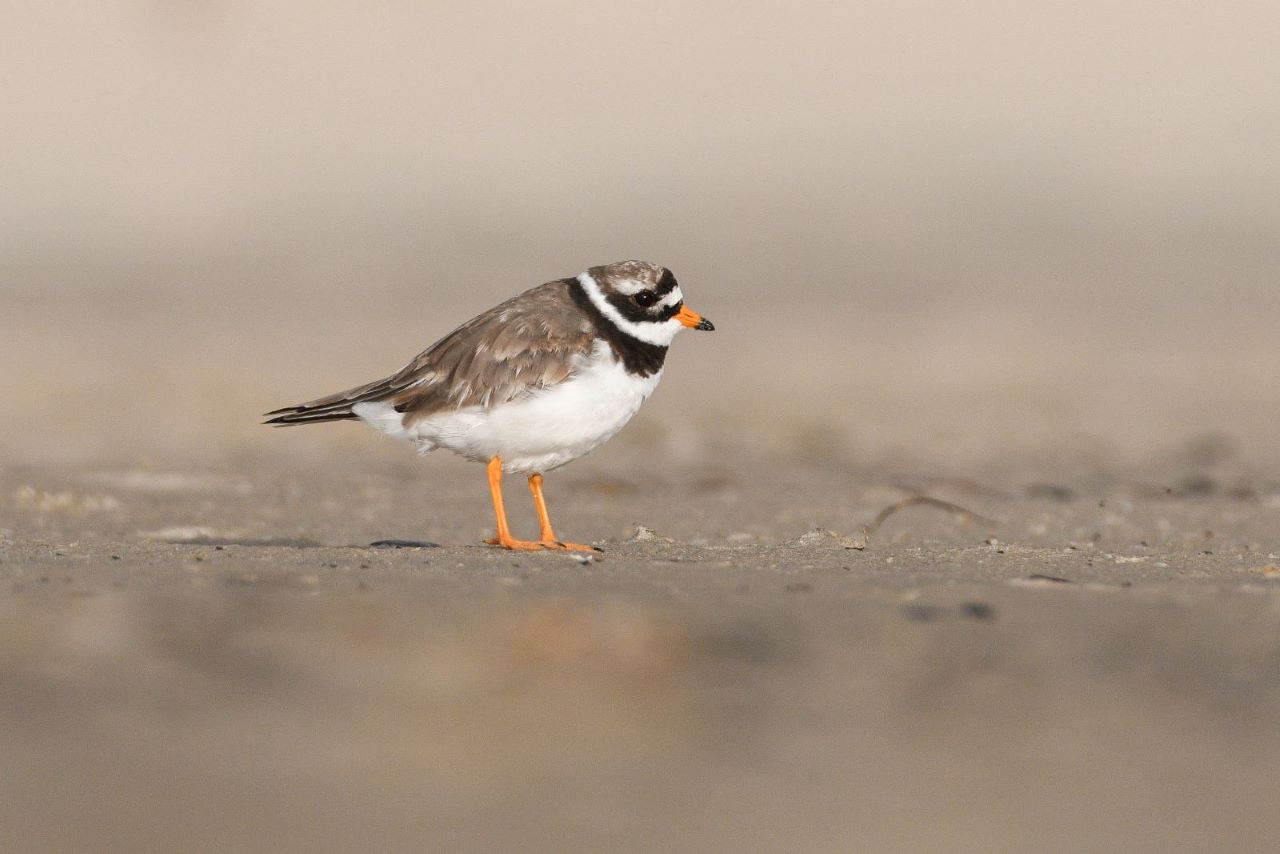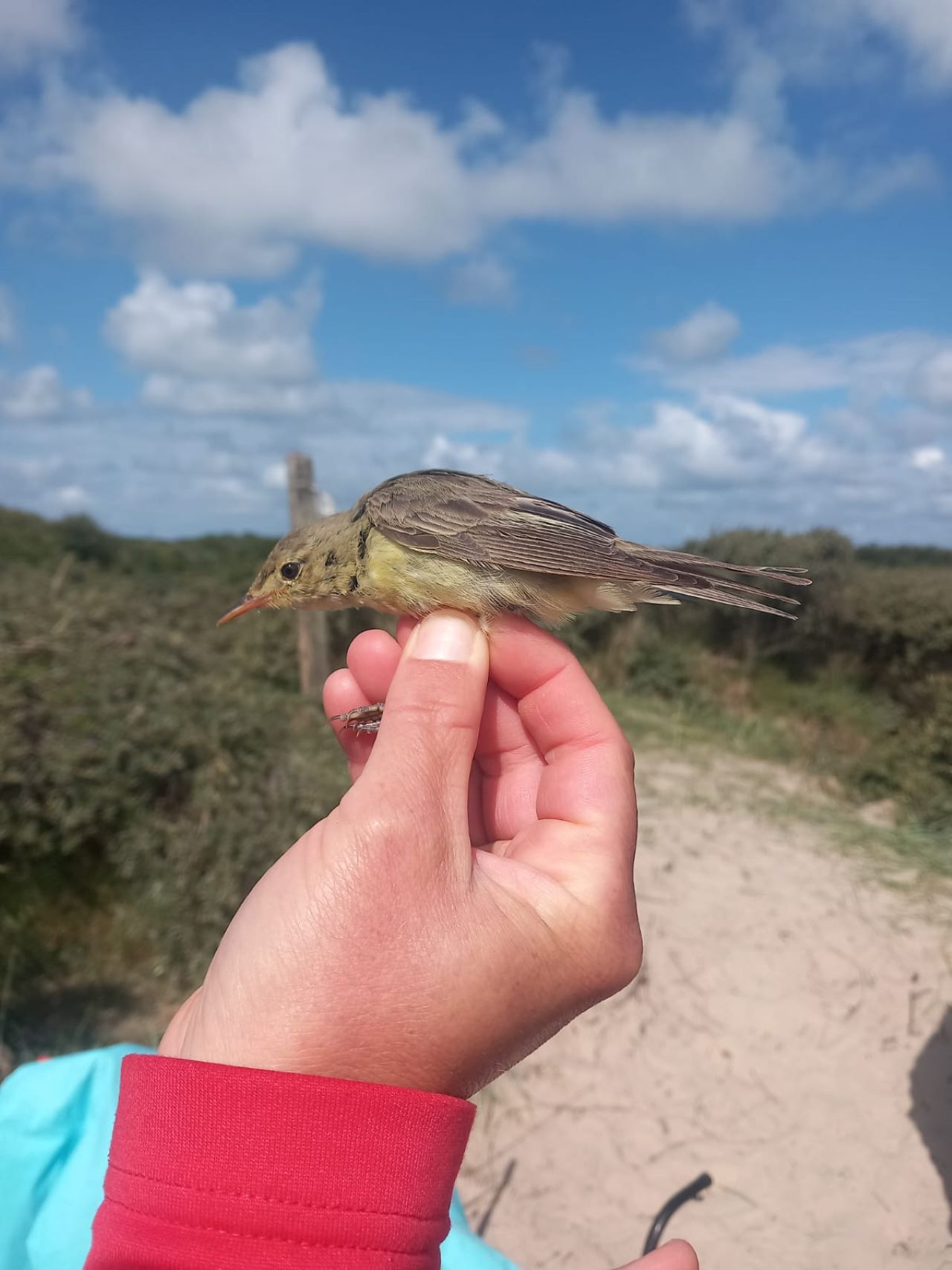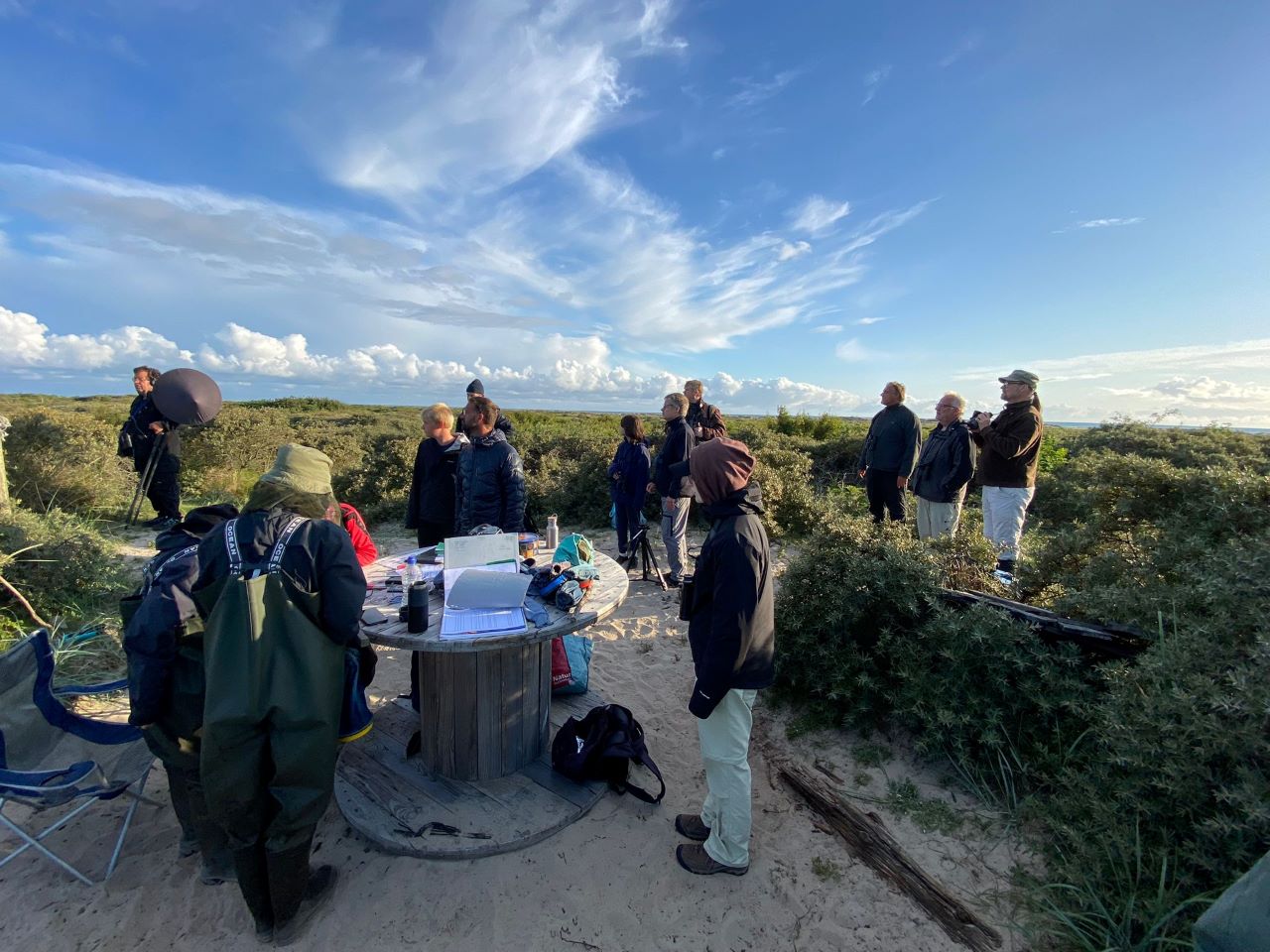Her på Skagen Fuglestations blog bringes korte nyheder i dagbogsformat om hændelser på fuglestationen.
Se indlæg fra måned: jan. (1)feb. (8)mar. (31)apr. (29)maj (30)juni (28)juli (32)aug. (31)sept. (30)okt. (31)nov. (30)dec. (8)
Tornsanger love
Last night, Simon the first lead a night tour at the light house, where visitors got to see some of the nocturnal wildlife around our area, including natterjack toads, bats and some moths. We also had the nets open like the last few days, hoping for either storm petrels or nightjars, or both. On one of the net checks the group got to see a nightjar that flew around the nets, so they got a very good view of it – although some might have preferred to have the bird captured in the net so they could see it up really close, it was still a very nice bird to observe.
No birds caught again all night.
Experienced followers of bird migration may know what is needed now: a change of weather, meaning mostly a change of wind direction. Especially early in the season, when they are not yet in a hurry, birds do not like to fly against the wind, since it costs them so much more energy. Northerly winds are expected during the next two nights, so we hope that migration will pick up a little. Also with lots of rain in the middle of the country a lot of birds might get trapped around our area, meaning we might catch more than usual. On the other hand, seeing how little accurate weather forecasts were these last few days, the rain might also come north and we will not get any migration again...
Since last night it did rain almost everywhere apart from Skagen, no migration happened, or very little anyway. At the ringing this morning at Kabeltromlen then, Simon junior, Benjamin, and me, again, had only local birds. After all the whitethroats we ringed already, it is amazing that we still catch so many without rings. On the other hand, it is also good that we keep recapturing the ones that already have a ring on, because, for one, it means they are still alive (up to 90% of juvenile birds die within their first five months), but also it gives us a chance to see how they move around, when they start leaving the area, and, especially helpful for our new ringers: it provides a chance to follow the moult and learn to identify the different ages later on.
Today, we actually caught a common whitethroat (tornsanger) that we ringed only a few days ago at Skarvsøen. It is a young bird but apparently already quite adventurous, since it has moved around quite a bit. Mind you, there is a lot more sea-buckthorn around Kabeltromlen than at Skarvøen, because the dunes here are higher and it is generally a little drier. All the Sylvia species currently feed almost exclusively on the berries of this bush. It is also the food they use to put on fat for their migration later on, however, first they have to finish their moult.
Of course, they are also very pretty birds:
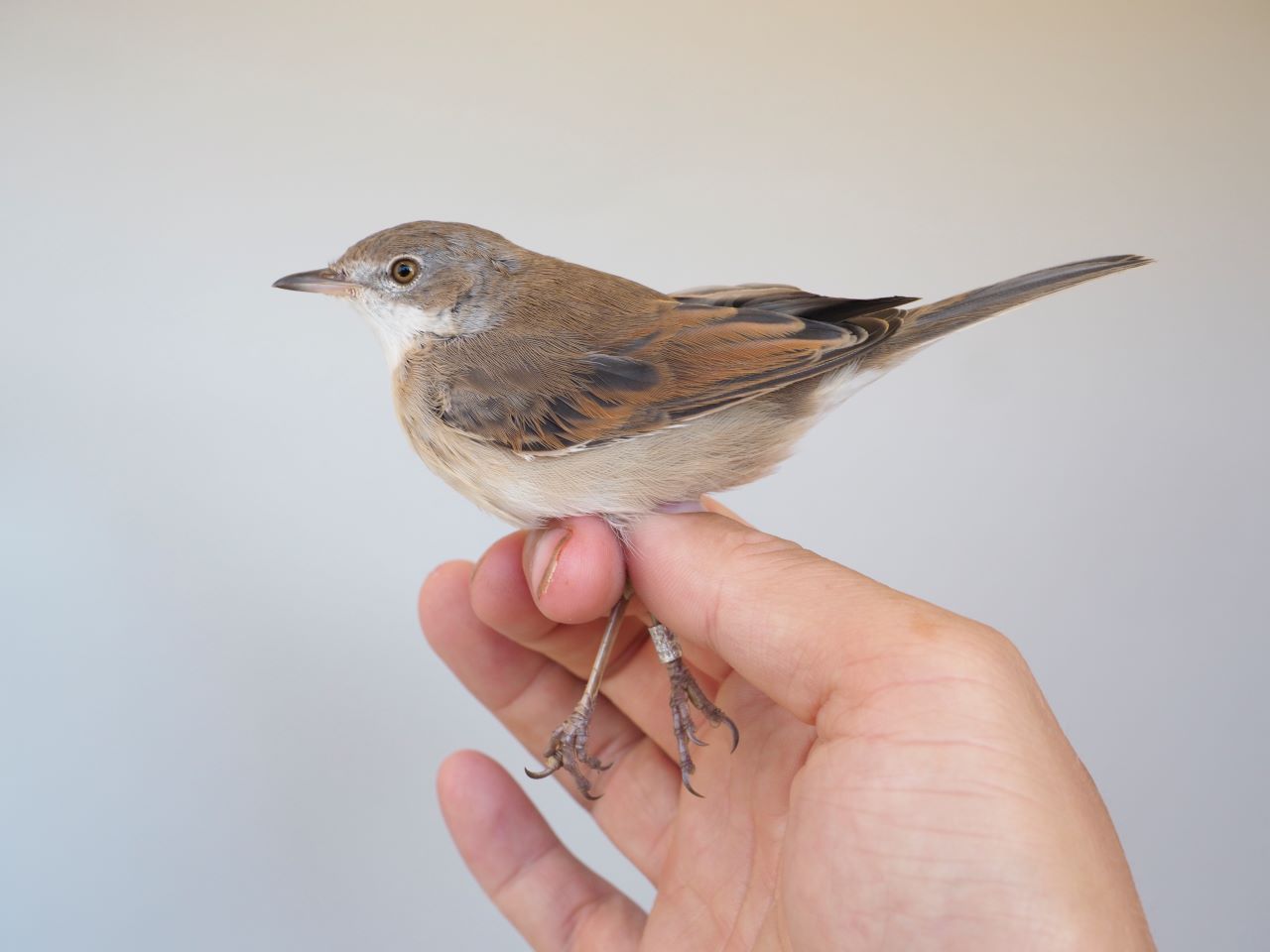
The other two Sylvia species (lesser whitethroat/gærdesanger and blackcap/munk) are also amnog the very common local breeding birds and on top of our current list of species caught most often.
Benjamin has been out ringing with us for the last time during these holidays, since soon he has to go back to school. But he noticeably improved his skills both in identifying birds and doing the recording for us, so we really look forward to have him as a "real" volunteer next year, when he is 15 and therefore old enough to get a trainee ringing license.
Sean, although he stayed up all night, went out in the morning in the hope of seeing loads of shorebirds and migration going on at the tip. He soon gave up, though, and settled to sleep instead.
At Grenen beach, the shorebirds have remained more or less constant over the past few days, quite enjoying themselves in the many puddles the rain has left behind. Also there are red-throated divers (rødstrubet lom) resting in the water very close to the shore. This species is breeding in Sweden and Norway and the birds we observe now are mainly second-year birds, that do not breed yet. Some of them have their very pretty breeding plumage, they may also be older birds that did not find a mate or for other reasons chose not to breed this year.
Because lately the light has been so beautiful in the cloudy evenings, here are a couple of pictures of last night’s sunset out at the beach at Grenen.
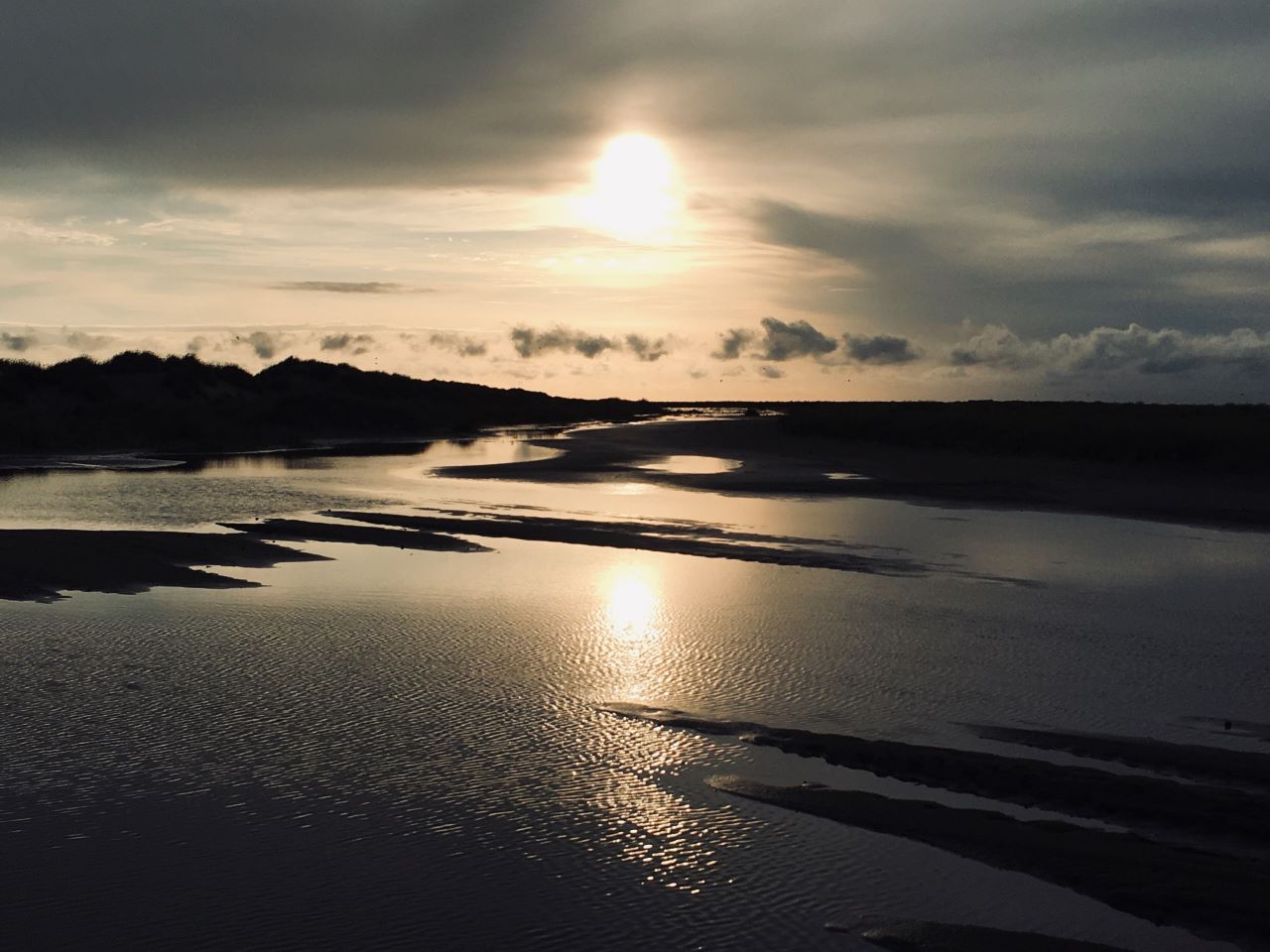
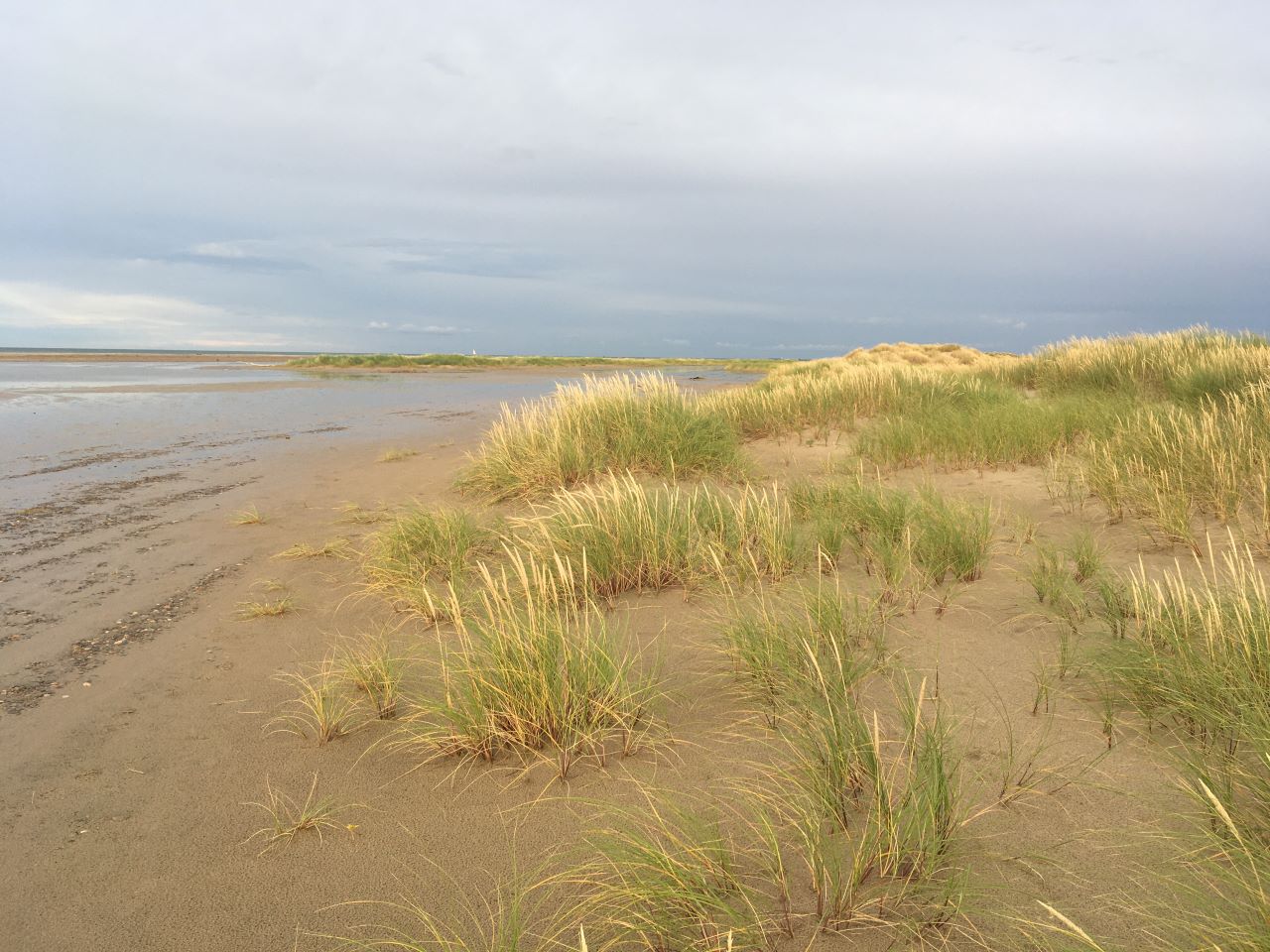
Ringing (Kabeltromlekrattet)
Munk (Blackcap) - 2
Tornsanger (Common Whitethroat) - 9
Gærdesanger (Lesser Whitethroat) - 3
Gransanger (Chiffchaff) - 3
Blåmejse (Blue Tit) - 3
Lille Gråsisken (Redpoll) - 1
Total: 21
People: Seán Walsh, Martina Hillbrand, Simon Kiesé, Simon S. Christiansen, Lisa Vergin Benjamin Bech, Lise, Tine and Elinor
A link to today's observations from volunteers and local observers.
Orcas
Last night, once again, Simon and Benjamin stayed up all night with several interested guests, hoping to catch either storm petrels (stormsvale) or nightjar (natravn), however, again they were unlucky. The weather forecast has, once again, fooled us quite a bit. It did not rain at all at night, so the promised good conditions did not happen, unfortunately. Mind you, tonight, the rain has come and will probably stop before the nets are set up, so, who knows, maybe, finally we will get lucky again...
Sean and I got up at 3 am, while the others closed the nets at the lighthouse, in order to go ringing at Kabeltromlen again. Originally, the weather forecast had forecasted no rain at all this morning, then the current rain radar showed it to be pouring most of the morning. Despite that we stayed quite dry and we, luckily, did not have to close the nets early.
The ringing today, despite the weather, was quite interesting, although, most of all, we caught only juveniel whitethroats (tornsanger). The second brood probably just hatched and the young are moving around quite a bit now. Since whitethroats are breeding at a very high density in the dunes, there must also be nests close to our nets, so we catch them very regularly.
Also, as a nice surprise, we cuaght the first wren of the season, also a juveniel, quite young still, so must also have been born around the area. Also we caught the first juvenile blackbird today, if I am not mistaken.
And we had a recaputre of a very colourful adult male yellowhammer (gulspurv). Although they are also breeding at a high density, Yellowhammers are often observed and always heard but not so often caught.
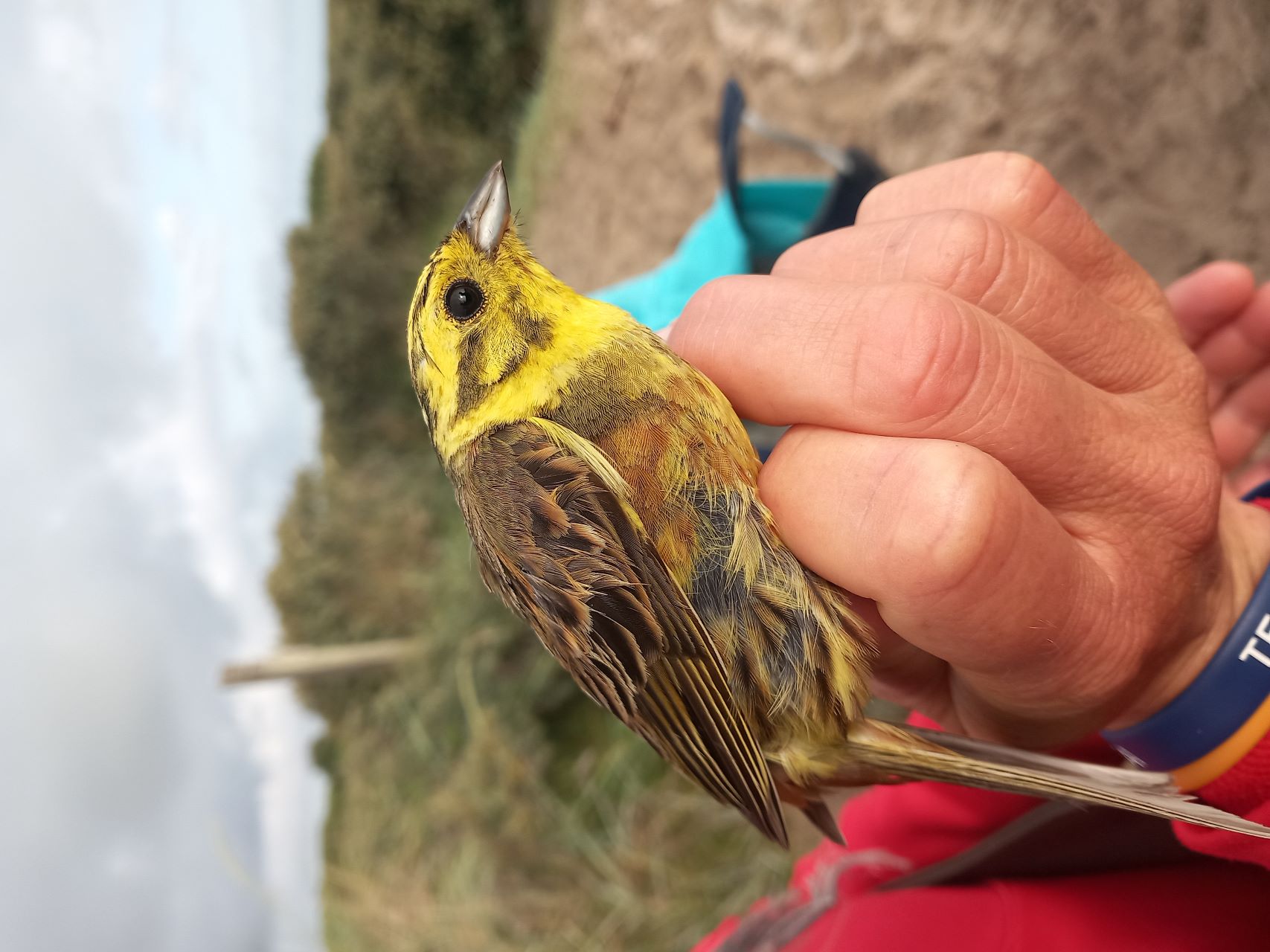
On the migration side of the bird species range, today we caught only one sedge warbler (sivsanger), which is a bird not lcally breeding so it should be a bird from Sweden or Norway. We do not catch them often, however, because sedge warblers follow a migration strategy where they use very few stopover places, and instead, when they are in one place, put on huge amounts of fat (they can almost double their weight!) in order to then go very long distances without feeding again. If they land for the day then they just sit in a bush and don’t move, so they would not be caught, normally.
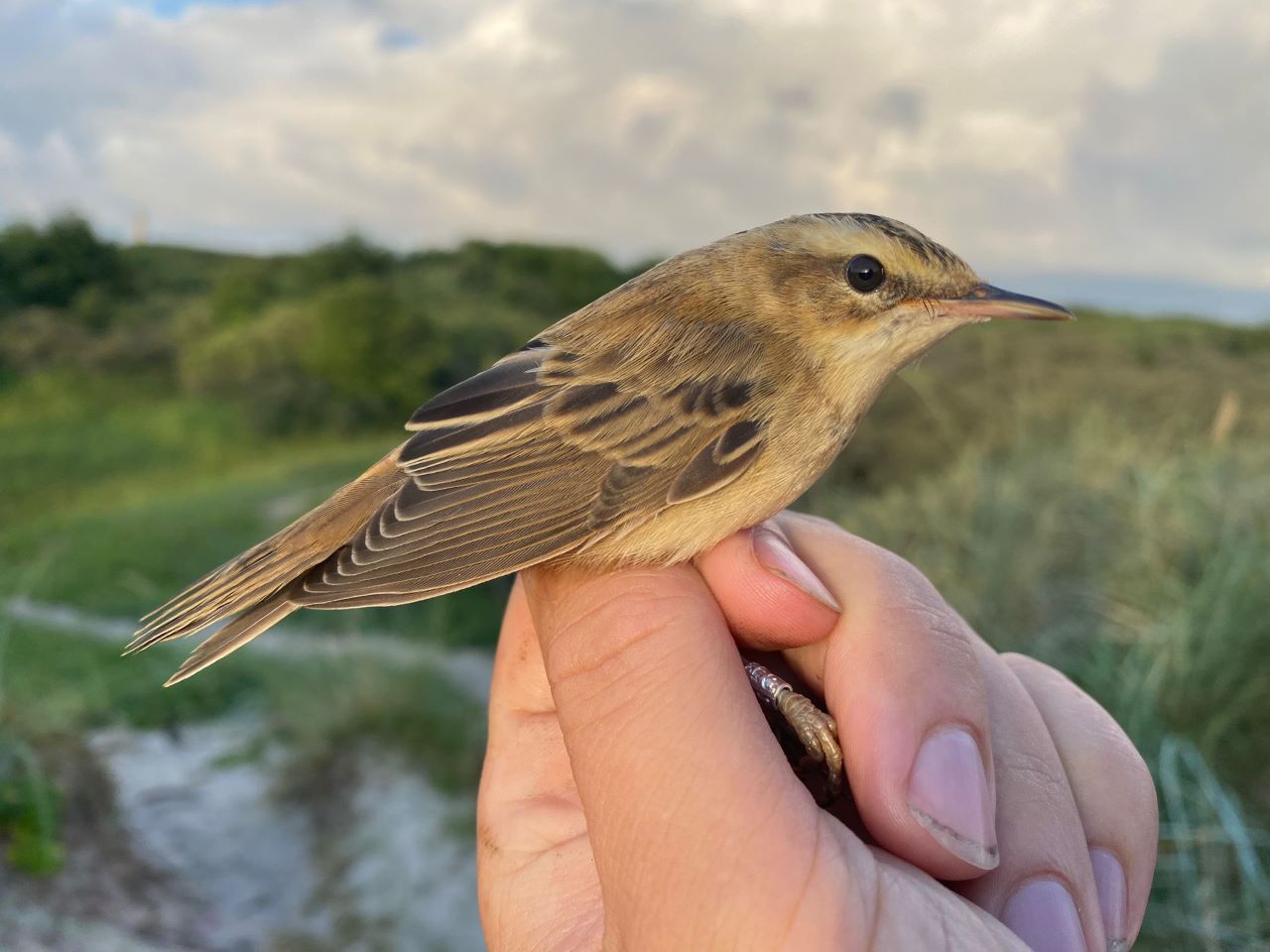
On the mammal front there have been news today. A flock of four Orcas as seen at Grenen and Nordstrand. From Kabeltromlen we did not get to see them, however, most people who went to the beach or to World’s End saw them. Also Simon got a good look at them, after he joined us for ringing for a while. The orcas will probably stay in the area for a while, as they were observed hunting a seal, so they probably like this place. If you go out this week, always keep an eye out for them!
In the afternoon we did some cleaning, the data entry and all that is required to keep the station going. Also, our new guests for the week arrived: Tine, Lise and Elinor. It is their first stay here and we hope they will enjoy it!
Tonight, there will be a guided night tour and again, we will try to catch birds at night. Since the weather forecast has been so unrelyable lately, I will not make any predictions, but the plan is to go ringing at Kabeltromlen again tomorrow.
Ringing (Kabeltromlekrattet)
Solsort (Blackbird) - 1
Munk (Blackcap) - 4
Tornsanger (Common Whitethroat) - 11
Gærdesanger (Lesser Whitethroat) - 1
Gaerdesmutte (Wren) - 1
Sivsanger (Sedge Warbler) – 1
Gransanger (Chiffchaff) - 1
Blåmejse (Blue Tit) - 1
Grønsisken (Siskin) – 3
Total: 24
People: Seán Walsh, Martina Hillbrand, Simon Kiesé, Simon S. Christiansen, Lisa Vergin Benjamin Bech, Lise, Tine and Elinor
A link to today's observations from volunteers and local observers.
Reed Birds
Tonight, again, a ringing session took place and around 30 visitors, all eager to see a storm petrel (stormsvale) came and sat through the night, not giving up hope until the end, however, no luck this time. Conditions would have been just like Thursday night, but maybe this time it was too quiet out at sea. Mind you, tonight it won’t be quiet for sure with several rain bouts moving through, so despite the somewhat uncertain weather, we decided to still give it one more try and who knows, the rain might yet push a storm petrel towards our shore.
Simon junior and I slept through the whole of tonight’s adventure, somewhat happy to not be woken up for a bird, so we could catch up on some sleep, since, again, we got up at 3am to go ringing at Kabeltromlen. After yesterday at Skarvsøen, the masses of mosquitoes came as a rather unpleasant surprise, although, of course, they are normal around this time of year, and they are important bird food, so often, lots of mosquitoes also means lots of birds and that’s what we had.
We started slow, but then the day turned out to be really good and we stayed up until noon. We caught mainly the local breeding birds, however, the first migrants are being put into the mix, for example, willow warbler (løvsanger). One of the locally born birds we caught was a water rail (vandrikse). It was still quite young, and it was really cool to finally see the birds up close that normally are very well hidden between the reeds, and although we hear them a lot, so we know they are there, it is very rare that one actually gets spotted.
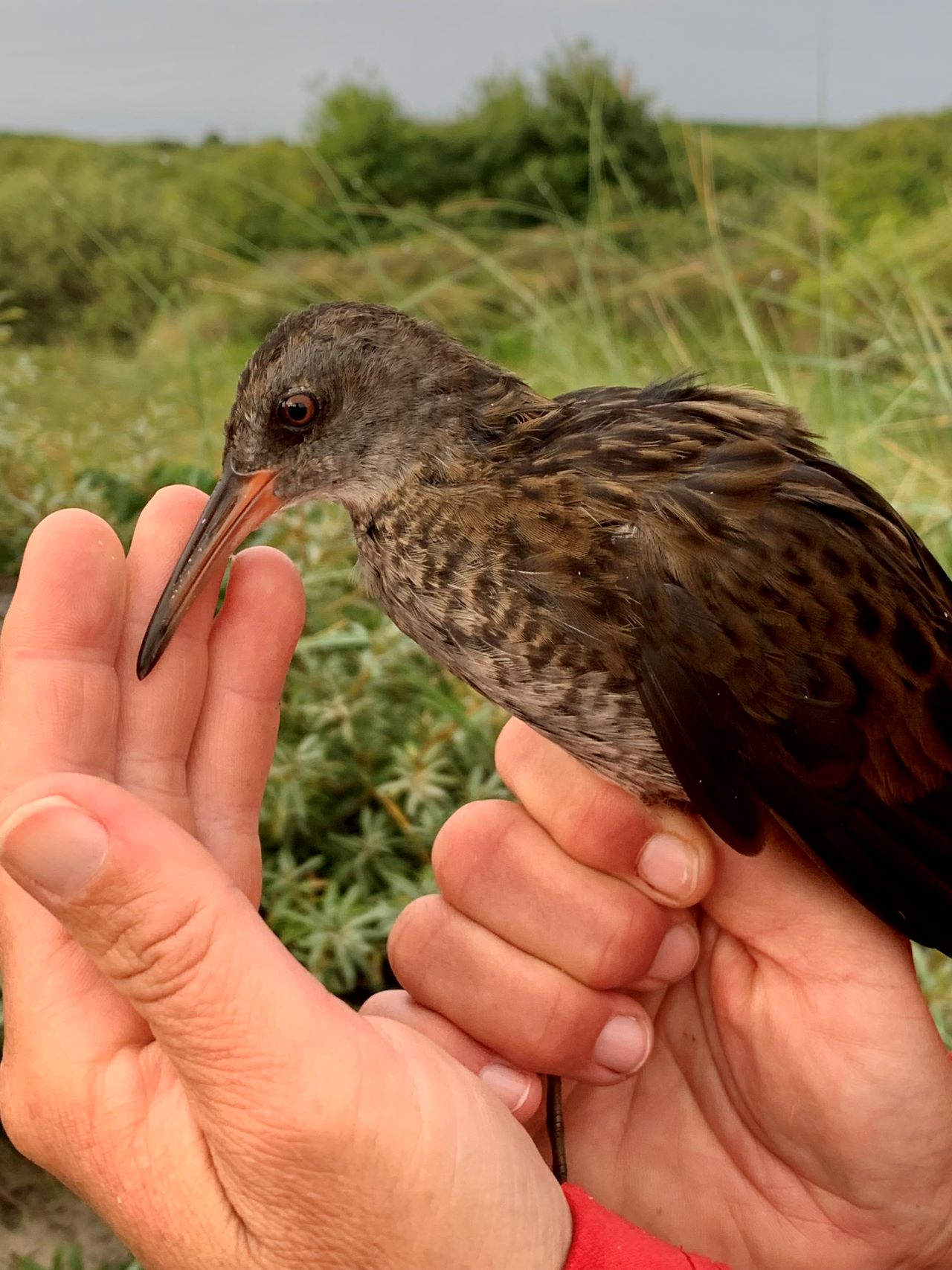
Like most rails, water rails do not fly much, they just walk around between the reeds looking for whichever food they can find, not being too picky about what’s for dinner. Although they are one of the bigger birds we catch, their bodies are very slim, so they can move between the dense vegetation in the reeds. The northern and Asian populations are migratory, so despite the very short wings, this bird is able to fly quite long distances when the weather around here gets too cold and days get to short, so our new friend might spend the winter somewhere in the Mediterranean. However, like most bird species that rely only on wetland habitat, numbers of water rails are declining, so every young bird we get is a good sign for a potentially endangered species.
Towards the end of the morning, we also caught bearded tits (Skægmejse) again: first a male, and in the next net check the female that it was paired up with. It was cute to observe the close bond between the two birds: while the male was in the net, the female kept talking to him from the reeds. Then, when the male was gone, the female flew into the net (whether on purpose, because she thought it would be something like a magical gate to another world, or by accident, because she was trying to follow me, when I took her partner away, I don’t know). After we ringed and released the female, we could immediately hear them calling to each other, so obviously the male had waited for his partner close to the ringing table.
It was also cute to observe Simon junior when he got to ring the male, he was very happy, it being his first – and, of course, they are just very pretty birds:
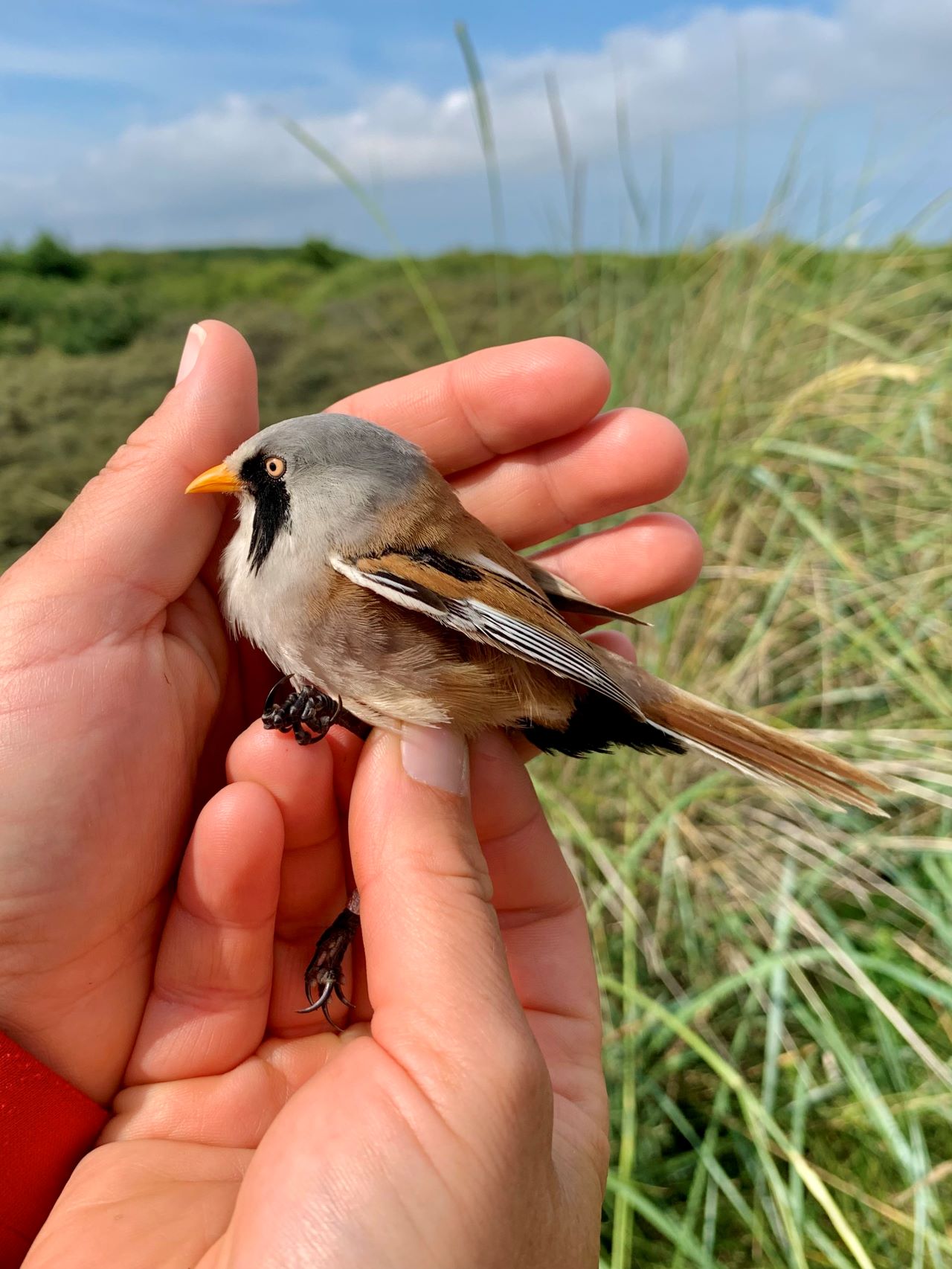
After the ringing, we cut the all-too-fast-growing vegetation in the net lanes, went shopping for food, cleaned and slept a bit, while Sean was cooking delicious dinner once again (dear future volunteers: expectations are set really high now, so maybe you should start to practice your cooking already and find some good recipes!).
And finally, tonight Simon the first and Benjamin will again entertain any visitors hoping to still catch a storm petrel this night, while the rest of us get to sleep so tomorrow we can catch even more birds at Kabeltromlen. If you come for a visit, don’t forget to be prepared for mosquitoes!
Ringing (Kabeltromlekrattet)
Water Rail (Vandrikse) - 1
Munk (Blackcap) - 6
Tornsanger (Common Whitethroat) - 8
Gærdesanger (Lesser Whitethroat) - 6
Rørsanger (Reed Warbler) - 4
Kæersanger (Marsh Warbler) - 3
Gulbug (Icterine Warbler) - 2
Løvsanger (Willow Warbler) - 1
Gransanger (Chiffchaff) - 8
Musvit (Great Tit) – 1
Skægmejse (Bearded Tit) - 2
Lille Gråsisken (Common Redpoll) - 4
Rørspruv (Reed Bunting) - 1
Total: 47
People: Seán Walsh, Martina Hillbrand, Simon Kiesé, Simon S. Christiansen, Lisa Vergin, Anton Arnesson & Benjamin Bech
A link to today's observations from volunteers and local observers.
Sleepless nights
The weekend kicked off a little early on Thursday night with an impromptu Storm-petrel (Stormvale) and Nightjar (Natravn) ringing session with the calm weather. Simon, Lisa, Martina, Simon K., Benjamin and I began setting nets and speakers up at the beach beside the lighthouse around 10pm while we could still see somewhat, and also put nets into the field across the road to try to catch Natravn. A moth trap was also set up in the lighthouse garden. Stormvale are known to wander the seas alone sometimes, and disperse at night, particularly younger birds of 2k or 3k. We caught our first one at around half 1 in the morning, a European Storm-petrel (Lille Stormsvale), 3k. The station staff and volunteers ringed the bird and took measurements, before taking it to the birders club for the crowd to take pictures of.
The second Lille Stormsvale was caught after 2am, also a third calander year bird. I opted to stay in bed this time, though, as Martina and I had to go ringing at the CES site, Skarvøen. We left at 03:20 to have the nets open by 04:30. It turned out to be a very good day for this site, which made us sad that we had to cut our ringing short at 6 hours due to the CES.
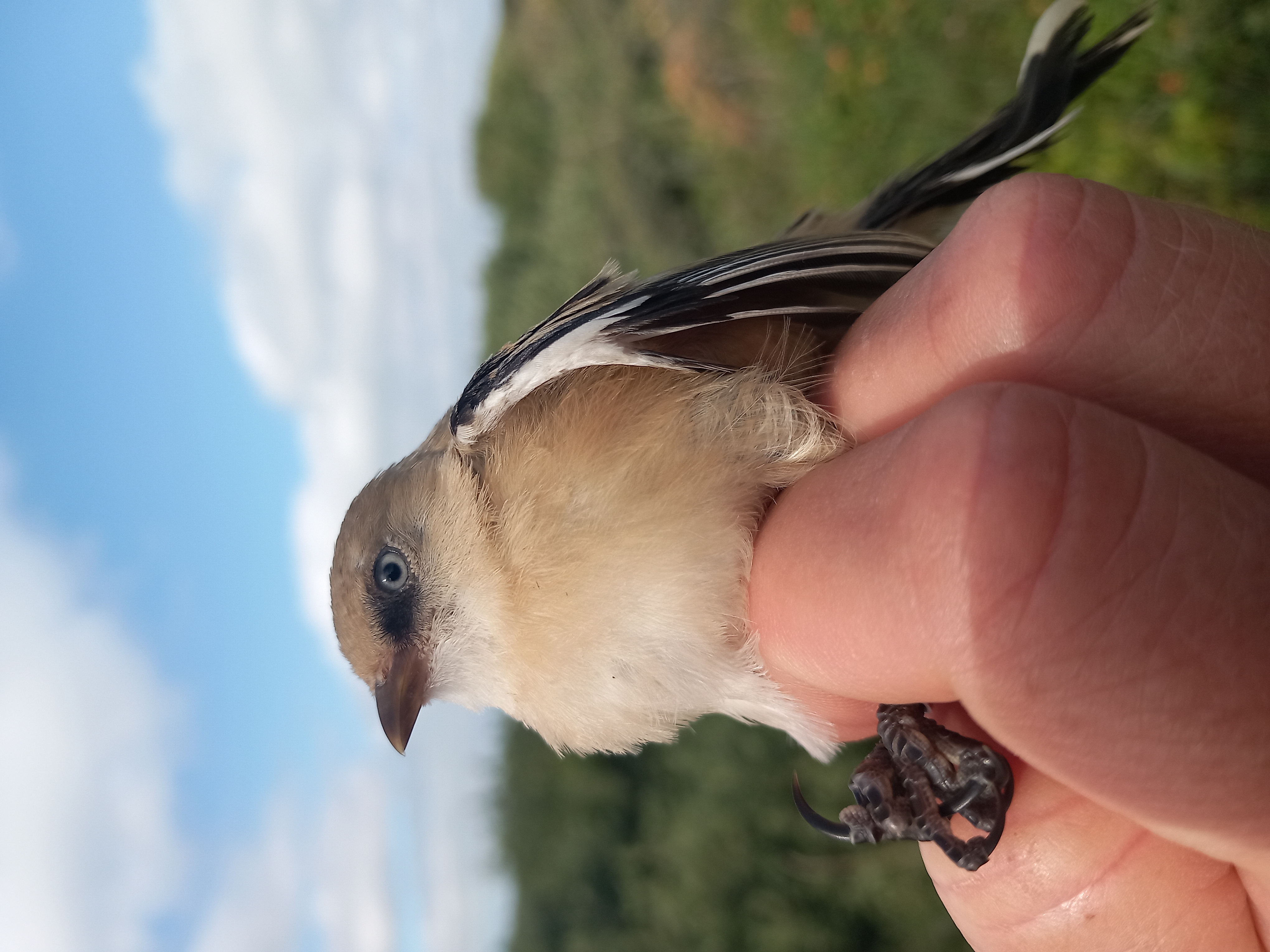
Tonight there will be Stormsvale ringing again, so I'm writing this trying to stay awake.
Ringing totals (Skarvsøen): 49
Solsort: 2
Musvit: 2
Rørsanger: 18
Lille Gråsiskin: 3
Gærdesanger: 2
Tornsanger: 6
Munk: 1
Rørspurv: 3
Blåmejse: 2
Skægmejse: 2
Gransanger: 8
Løvsanger: 1
Skagen People: Seán Walsh, Simon Kiesé, Martina Hillbrand, Simon S. Christiansen, Lisa Vergin, Benjamin Bech
A link to today's observations from volunteers and local observers.
Ringing after a rainy night
As the wind has died down, it was finally time for ringing at Kabeltromlen again today. For me it was the first time ringing since I arrived at the station, so I was very excited. The motivation was so high that Martina and I got up at 11pm and went to the beach in the hope of catching a gull. Unfortunately, we were not lucky and were surprised by a heavy rain shower.
Because of the rain, we didn't leave for Kabeltromlen until shortly after 4am. We opened the nets and were hindered by the masses of mosquitoes. Martina had warned me, but I didn't think there would be so many. Fortunately, there were fewer and fewer each round and the mosquito hat was a great help. Even though we didn't catch many birds, it was still nice to get to know the area, get in practice and learn a few things about moulting as I have never ringed at this time of year. Seán and Magnus stopped by after the count, but we were only able to show them a single bird from the round. The last round was at least a little better with 5 birds. Afterwards we first went briefly to the beach and saw a Red Knot (Islandsk ryle), and then went back to the station, where the delicious leftovers from yesterday's lasagne were waiting for our hungry stomachs.
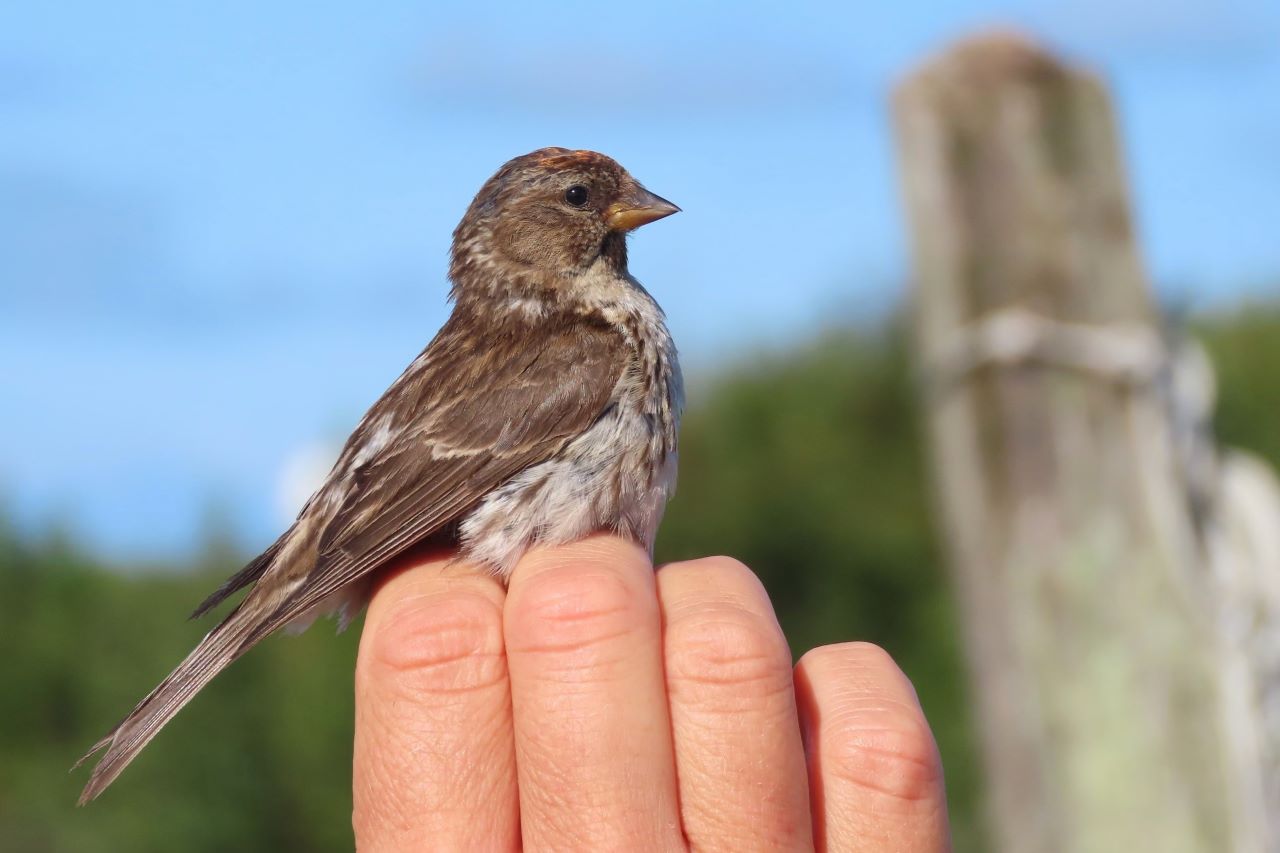 Lille Gråsisken (Lesser Redpoll) - thanks to Benjamin Bech for this nice picture.
Lille Gråsisken (Lesser Redpoll) - thanks to Benjamin Bech for this nice picture.
Meanwhile, Seán took care of counting the migrating birds again at World's End 3. Again today there were several observers on site. Like the last few days, several Arctic Skuas (almindelig kjove) were seen. In addition, two Great Skuas (Storkjove) and the next Manx Shearwater (almindelig skråpe) passed through this time. The heavy rain tonight has also resulted in many puddles forming on the beach, which are now being used by many waders to search for food. 2 Bar-tailed Godwits (Lille kobbersneppe), 1 Little Stint (Dværgryle) and 2 Spotted Redshanks (Sortklire) were there.
Now we are going to prepare everything for the night catching. In addition, we will not be ringing at Kabeltromlen tomorrow, as we will be in Skarvsøen, the CES site.
Tonight we will try to ring Storm Petrels (stormsvale). Due to the weather forecast, we will have a second try tomorrow night. I am really excited, so keep your fingers crossed that we will be successful!
People: Seán Walsh, Martina Hillbrand, Simon Kiesé, Simon S. Christiansen, Lisa Vergin & Benjamin Bech
A link to today's observations from volunteers and local observers.
Ringing (Kabeltromlekrattet)
Munk (Blackcap) - 1
Tornsanger (Common Whitethroat) - 5
Gærdesanger (Lesser Whitethroat) - 1
Rørsanger (Reed Warbler) - 4
Lille Gråsisken (cabaret) (Lesser Redpoll) - 1
Total: 12
Rain & Rainbows
Today, I slept in, while Sean and Simon headed to World’s End 3 for sunrise. They did, however, not stay very long, since soon it started raining and even though they tried to sit it out, more and more bouts of rain came over and they finally gave up. Before that they saw the regular arctic skuas (almindelig kjove) and, again, Simon managed to take very good pictures of one of them (an immature bird).
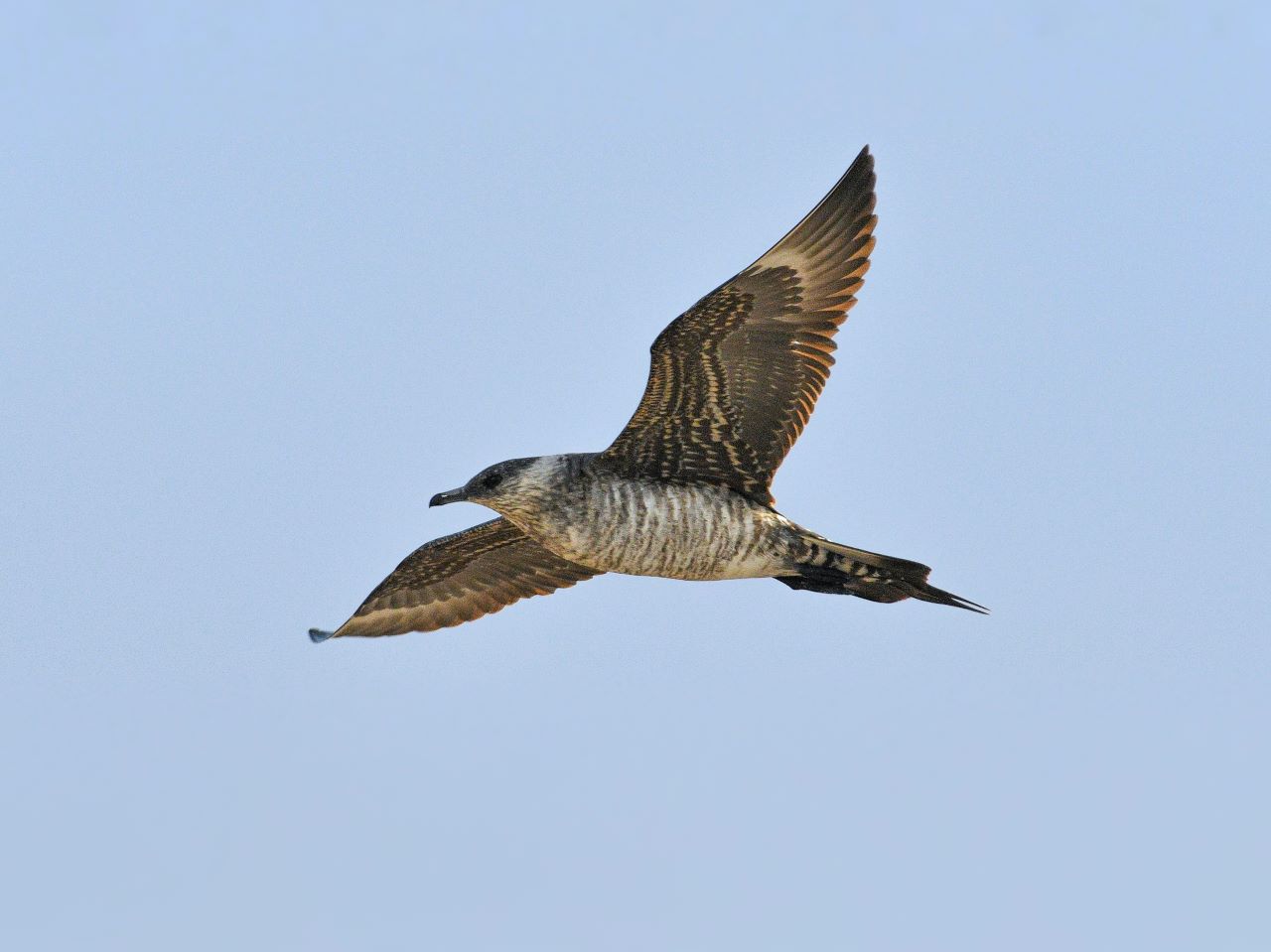
Besides, another manx shearwater (almindelig skråpe), and, a not so common sight in Grenen: a golden plover (hjejle), but only passing. And antoher of Simon's pictures to brighten up a rainy day: of a common ringed plover (stor præstekrave):
I got up at six, looked out of the window and saw a rainbow, which intensified over the morning, so I went to take a picture, which looks quite nice:
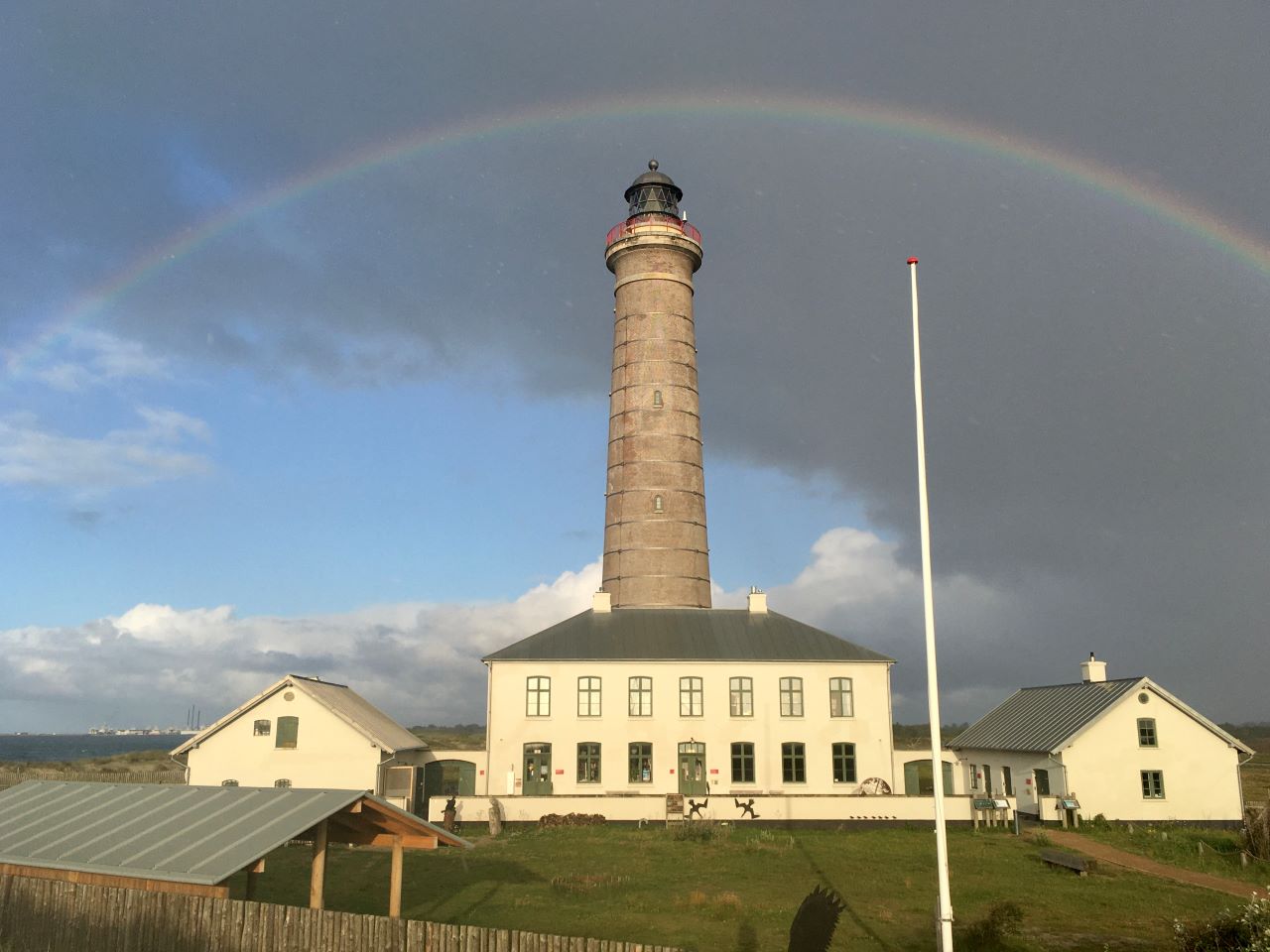
Simon and I went shopping in town, we cleaned and oiled the station's bicycles (lots of rust because of the salty air by the sea) and did some office work afterwards. I also went downstairs to visit the exhibition (which is new every year, so I haven’t seen this one. I think I discovered there a nest of a reed warbler (?) that we found last year when cutting the net lanes at Skarvsøen. Also, a lot of stuffed birds made it feel a little like home on Grenen beach – they made a very good choice there and I can totally recommend – if you are not too familiar with the local birds – to visit the exhibition before going to the beach, because it will help you to recognize a lot of the birds you will see out there.
Mind you, the skuas are not part of the display. Maybe in future series they have to be added if they keep hanging around. On the other hand, the so-called sandstorm indoors does not really feel much like a Grenen sandstorm at all, so for that, you will have to go to the real beach on a windy day. But in the exhibition, you (or your children) get to play with sand quite a bit and to try out really fancy, high-tech microscopes!
Most of all, however, the day was spent relaxing, reading novels, playing computer games etc. For my part, I checked the weather forecast about every 5 minutes, really hoping that tomorrow will be good for ringing. It will be, I am sure!
Also, as announced earlier, we will try to ring storm petrels (stormsvale) this weekend. Due to the weather forecast, we will have a first try tomorrow night (Thursday to Friday), then a second try the night after. If the announced activity on Saturday night can happen, depends on the weather. We will keep you posted.
People: Seán Walsh, Martina Hillbrand, Simon Kiesé, Simon S. Christiansen, Lisa Vergin & Benjamin Bech.
A link to today's observations from volunteers and local observers.
Postscript: Simon cooked his first communal dinner tonight. I am not quite sure if it was the first time ever that he cooked. Sean was a great mentor to him, in any case, and shoutout to Simon’s mum: you can be proud of your son, he did very well!
More windy days and old friends visiting
Today, again, we could not go out ringing, this time because of wind. Instead, all of us went to World’s End 3 for a seawatch. We were greeted by the by now resident Arctic Skuas (Almindelig kjove) and a rather beautiful sunrise, which is quite common here but it was Simon's first so he took this nice picture:
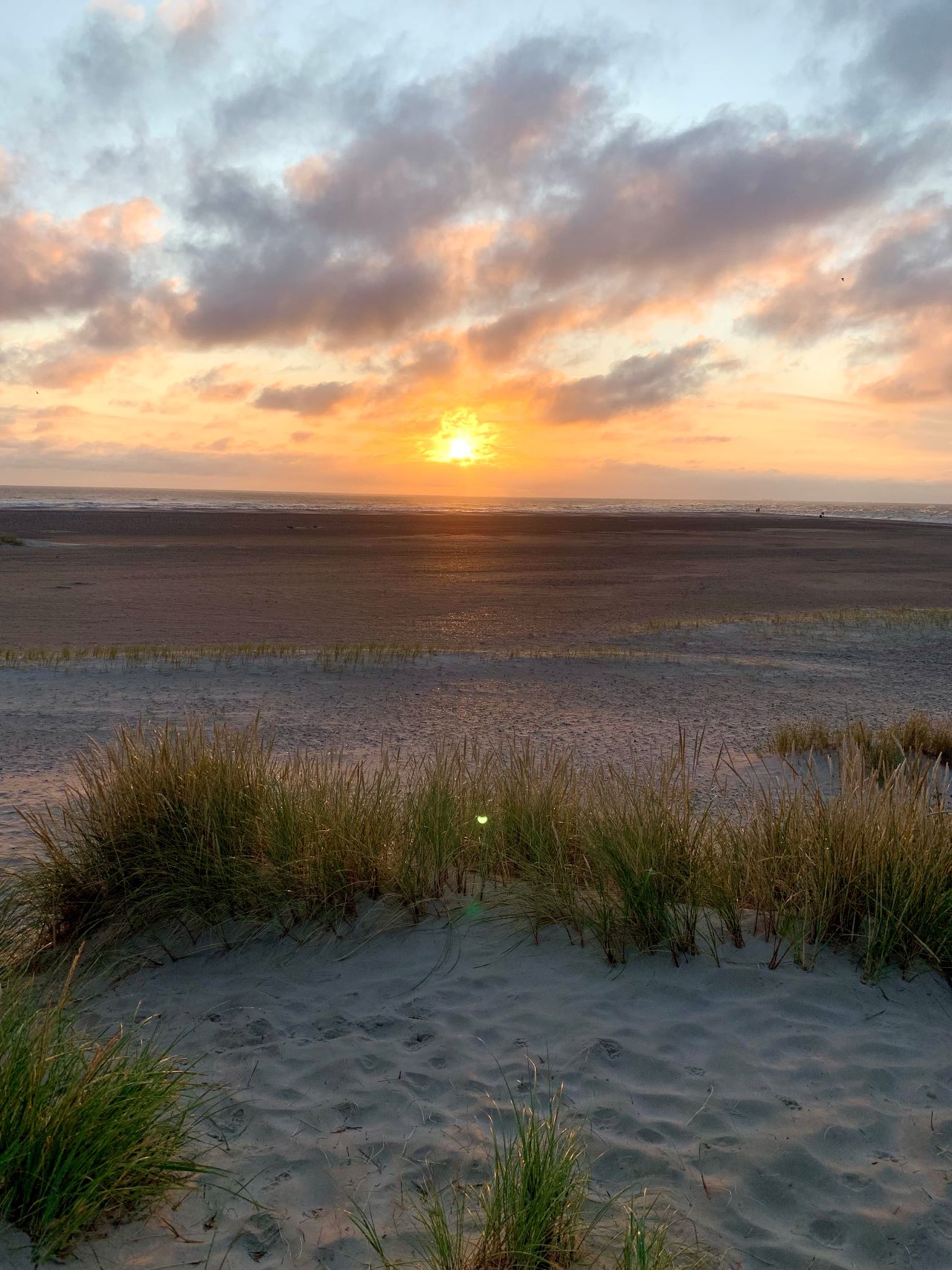 Other than that, it was a rather slow day for migration – the wind probably stopping especially smaller birds from migrating when they are not in a hurry. There were some rare species seen, however, including a pomarine skua (mellem kjvoe) which was playing cat and mouse with one of the arctic skuas right at the tip. Also, several manx shearwater (almeindelig skråpe) were seen roosting far out at sea.
Other than that, it was a rather slow day for migration – the wind probably stopping especially smaller birds from migrating when they are not in a hurry. There were some rare species seen, however, including a pomarine skua (mellem kjvoe) which was playing cat and mouse with one of the arctic skuas right at the tip. Also, several manx shearwater (almeindelig skråpe) were seen roosting far out at sea.
Some of the shorebirds seem to have left over night but a few sanderlings (sandløber) and 5 dunlins (almindelig ryle) were left together with the locally breeding common ringed plovers (stor præstekrave). Also, the terns are still on the beach, hunting in the shallow waters and taking the fish to their always hungry offspring.
Since there were so many people already doing the sea watch, after the first hour I left the group to go look for coulor-ringed gulls, with quite some success.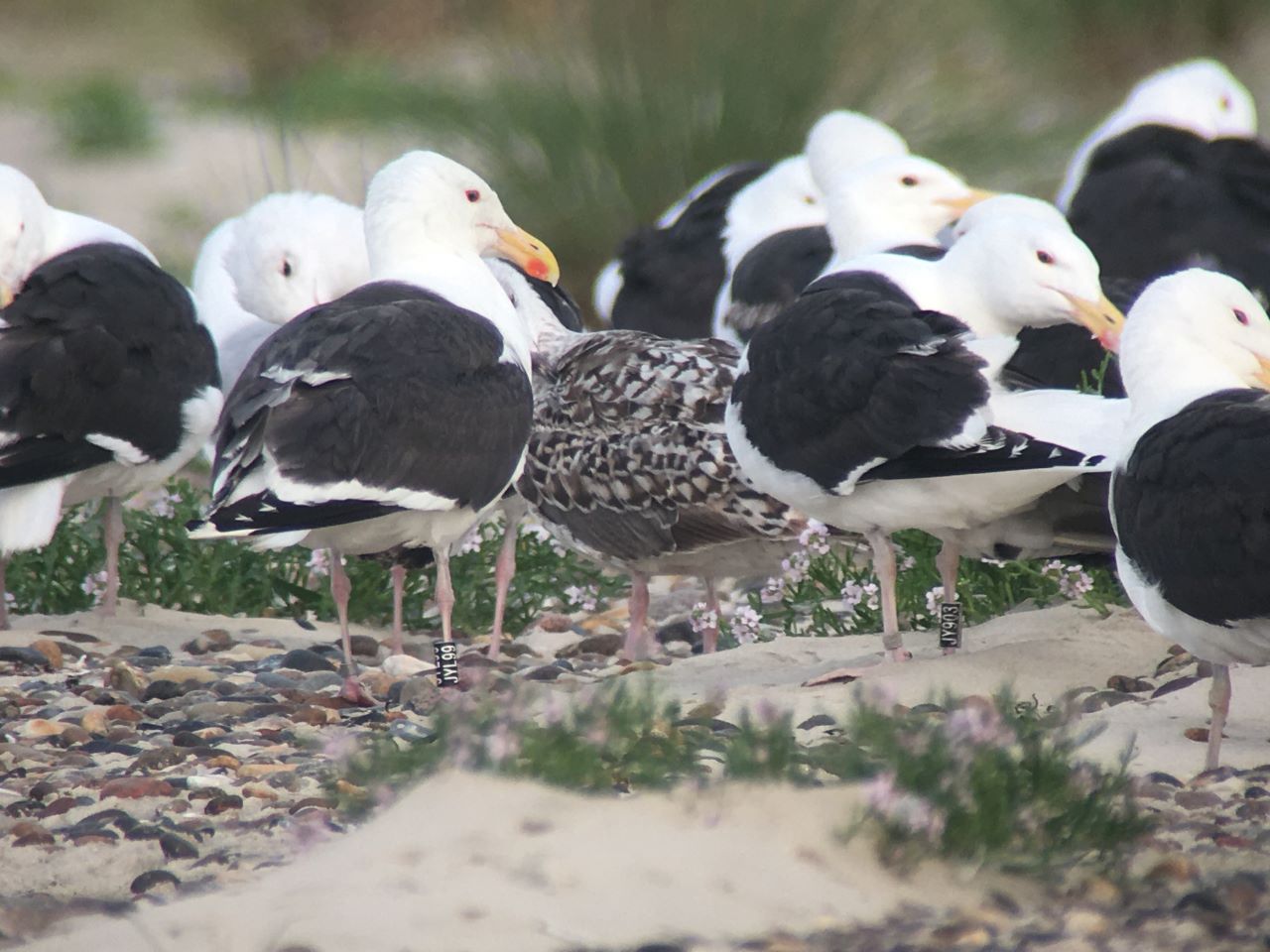
The greater black-backed gulls (svartbag) are all registered in a data base, so we can immediately get their information: these two were both ringed in July 2013 as chicks, so they just celebrated their 10th birthday each. Both were ringed in Nordjylland, however for the last 10 years the one on the left in the picture has spent them mostly around Hirtshals, whereas the one on the right spent most of the last 10 years in the Netherlands and was frequently reported from there.
In the afternoon it was the usual office work of entering data, cleaning and cutting reeds – this time a Skarvsøen to get ready for the next CES ringing which is going to be on Friday.
Besides that, I had the privilege of ringing a kestrel, although the circumstances were a little sad: The poor bird had flown into a window and was picked up by animal rescue. They kept and fed him for three days, after which they decided he should be well enough to release. They were kind enough to drive by the station before for him to be ringed. When we wanted to finally let him go, though, it seemed he was not yet strong enough to fly, so the rescue team had to take him back. But they say he has been eating well, so we hope that in a day or two he can finally fly off again!
Simon and Lisa picked up a swedish friend in Frederikshavn and went afterwards to Stensnæs where they swam to a small sandy island with the basestation in hope that it will download data from GPS-tagged Sandwhich Terns that potentially roost in the area down there.
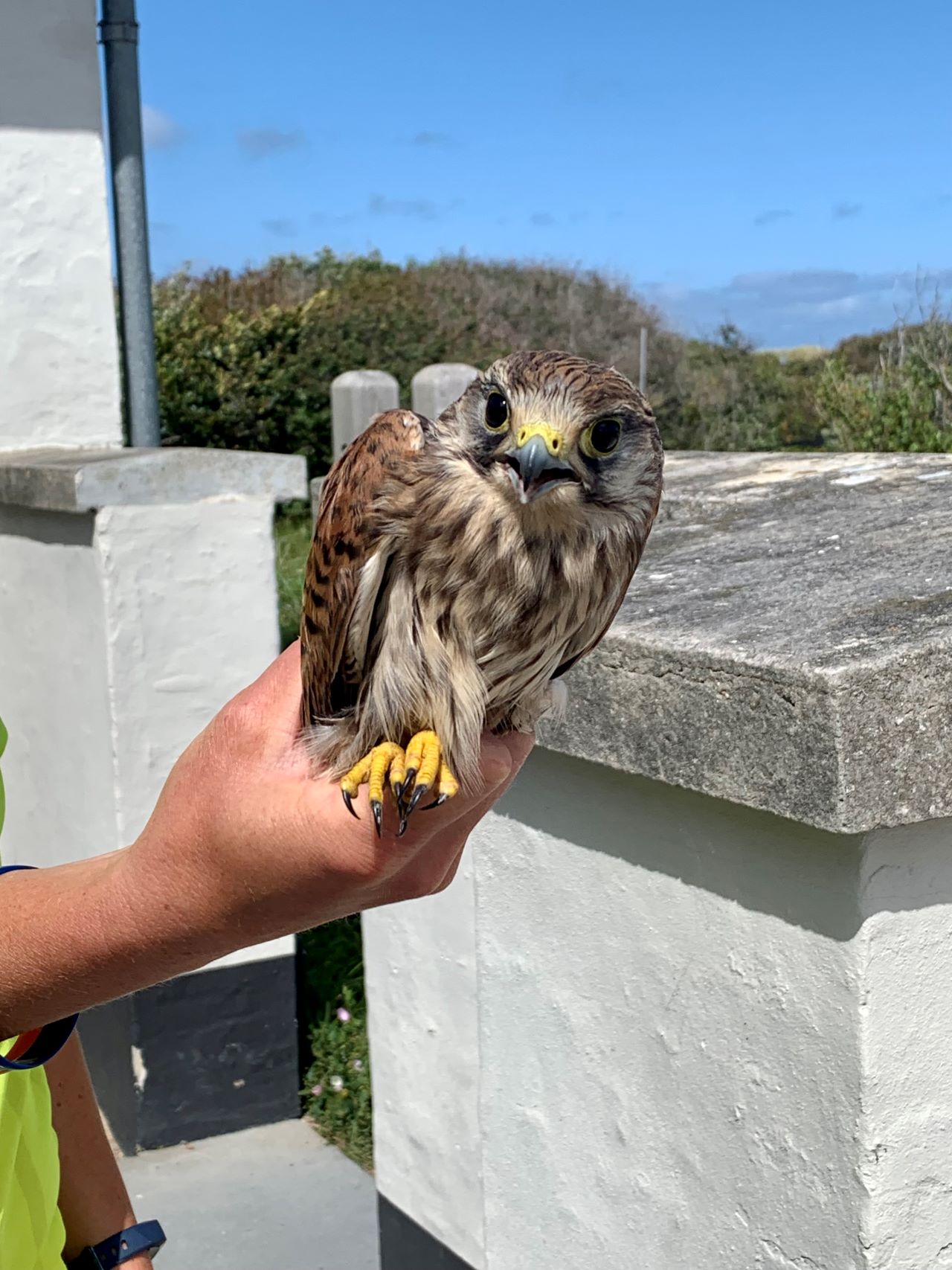
In the evening, we had another of Sean’s famous dinners and went to bed early to be ready for another seawatch tomorrow, seeing that the wind will again be too strong for us to do anything else.
People: Seán Walsh, Martina Hillbrand, Simon Kiesé, Simon S. Christiansen, Lisa Vergin & Benjamin Bech.
A link to today's observations from volunteers and local observers.
Ringing (Lighthouse):
Tårnfalk (Kestrel) - 1
Total: 1
The Autumn team
For the first time in a while, I slept in today. Martina was unfortunate though, as she was woken up by the lighthouse alarm going off at 1am. At 5am, she went out to Grenen to attempt to do a roost count of gulls and terns in the poor weather.
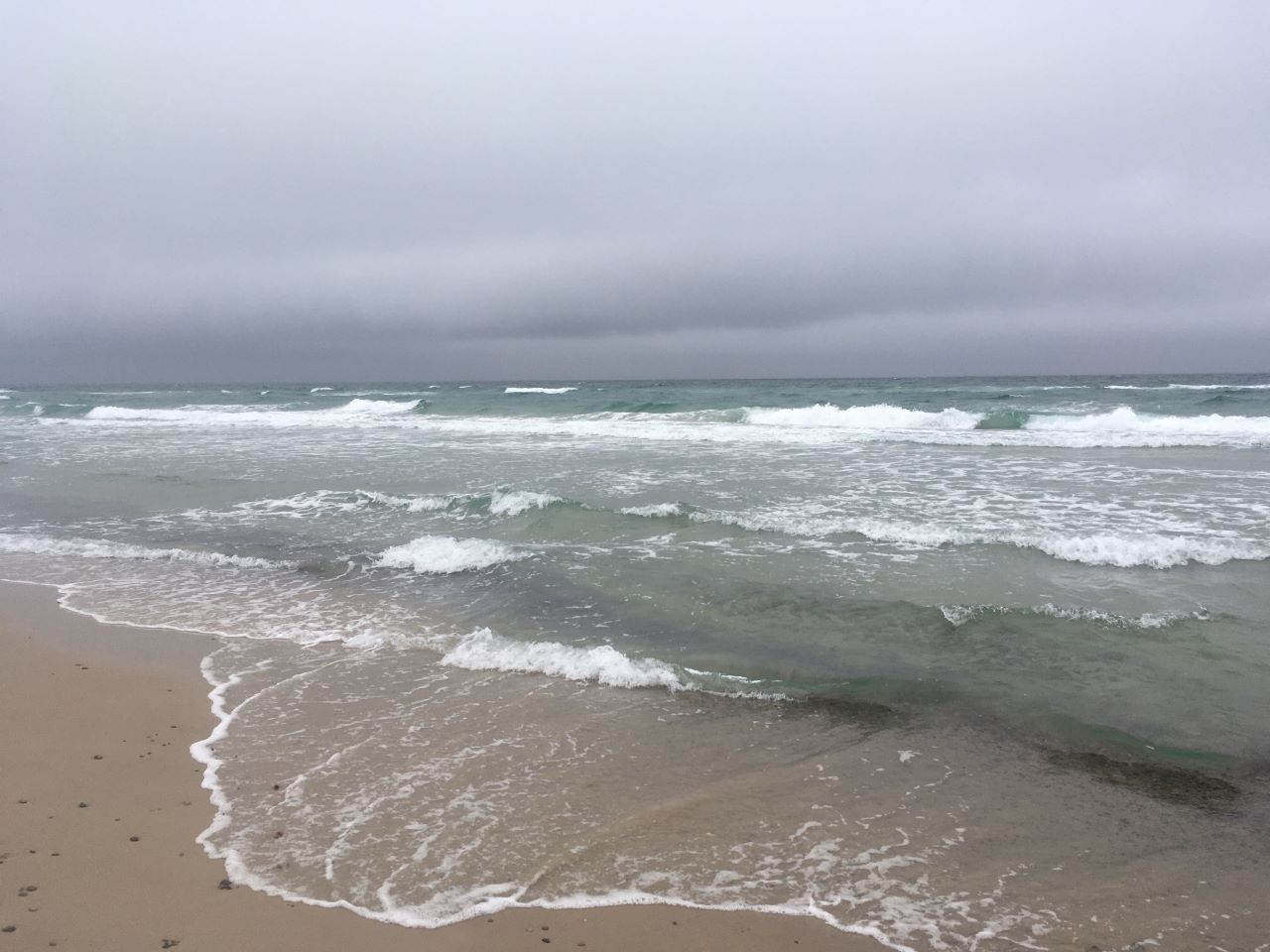 Unlike most weeks recently, there were very little in the way of roosting birds. And to add to the despair, a person walking the beach kept walking back and forth between gull roosts, flushing them and re-flushing them as they tried to settle back down somewhere. Martina gave up the roost count after a while. She was, though, happy to see five Almindelig Kjove (Arctic Skua) resting on the beach when she arrived.
Unlike most weeks recently, there were very little in the way of roosting birds. And to add to the despair, a person walking the beach kept walking back and forth between gull roosts, flushing them and re-flushing them as they tried to settle back down somewhere. Martina gave up the roost count after a while. She was, though, happy to see five Almindelig Kjove (Arctic Skua) resting on the beach when she arrived.
Today we also welcomed a young birder, visiting Skagen for the week, Benjamin Bech. After he arrived, we opened the nets in the lighthouse garden for a while but only caught one Gransanger (Common Chiffchaff). We saw a few birds go directly over the nets.
A while after Benjamin left the station and the nets were closed, Martina and I went into Skagen town to check out the gulls and cormorants at the harbour, but didn't find much there either. Afterwards, we headed to Netto to meet the newest volunteer, Simon (the 2nd)! He is an 19 year old birder & trainee ringer from Germany who is staying at the station until December. When Martina and Simon went out to the beach at night to place the base station for hopefully recording tagged terns at Grenen beach, Simon could already proof his photography skills on the skuas:
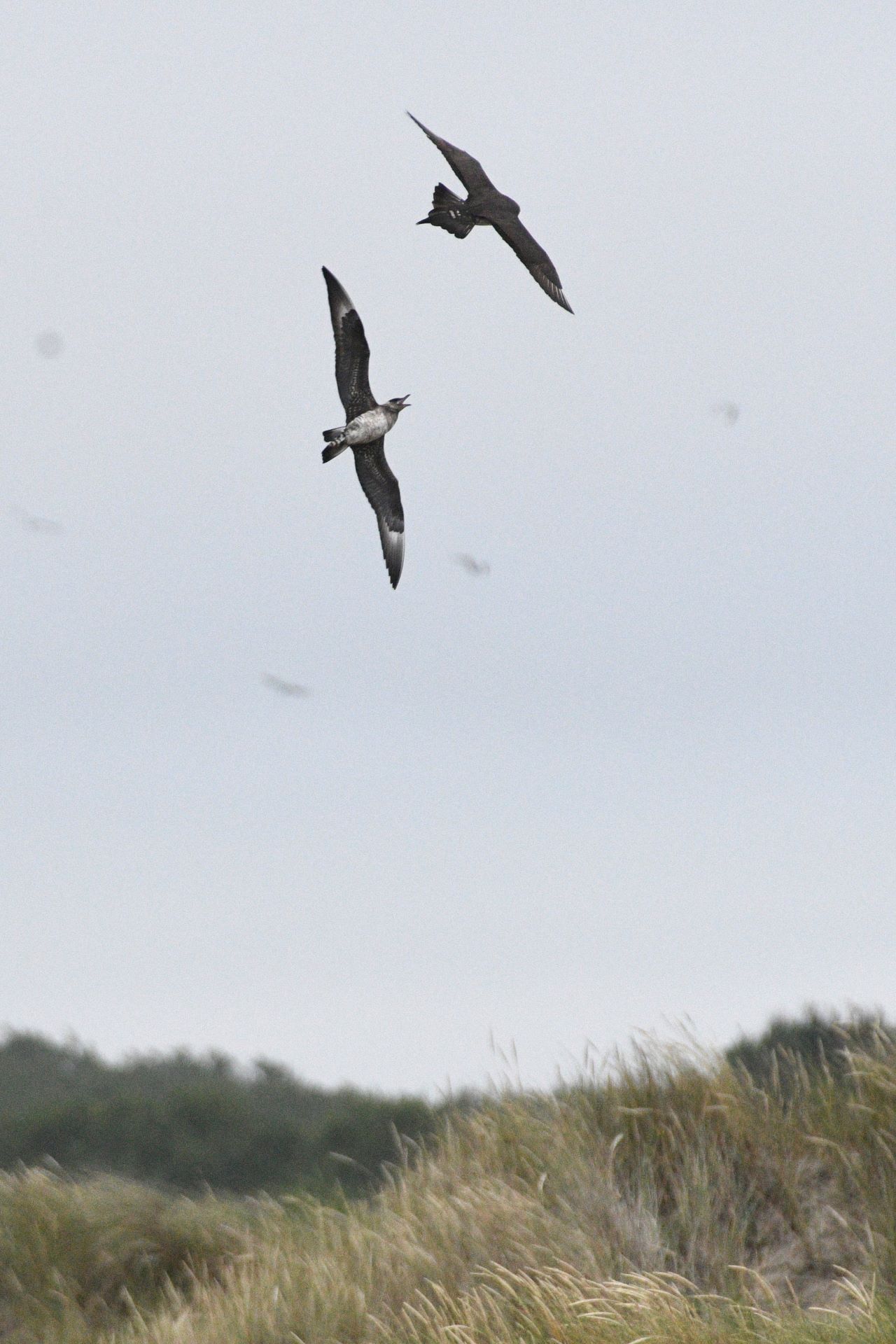
Tomorrow he, and Benjamin, will join us on our morning observations from sunrise.
Skagen People: Seán Walsh, Martina Hillbrand, Simon Kiesé, Simon S. Christiansen & Benjamin Bech.
A link to today's observations from volunteers and local observers.
Ringing (Fyrhaven)
Gransanger (Chiffchaff) - 1
Total: 1
Hello again
Hello everyone, it’s good to be here again! I arrived on Friday evening and since yesterday we already went out ringing, I have not done or seen much this far. Today again, we went out ringing, although, since Kalina, Mark and his kids all left early this morning it was a bit different with only Sean and me out. We had some visitors, though, which was nice for a change. Among them, Marcus and his two boys came by. They have been visiting the ringing for several years in a row and I was happy to meet them again. Also, we met Rolf’s sister’s family and I have a feeling that the two little girls will become very good birders one day. They were very into the ringing in any case.
As for birds, we did see the green woodpecker (grønspætte) again, but not much else out of the common. Also, we did not catch any foreign recoveries but I am not saying I am spoiled ;). Also, although it felt a little slower than yesterday, we actually caught the same number of birds, maybe a few fewer recaptures. But it is also that Sean is already getting very good and rather fast at ringing it felt like less work.
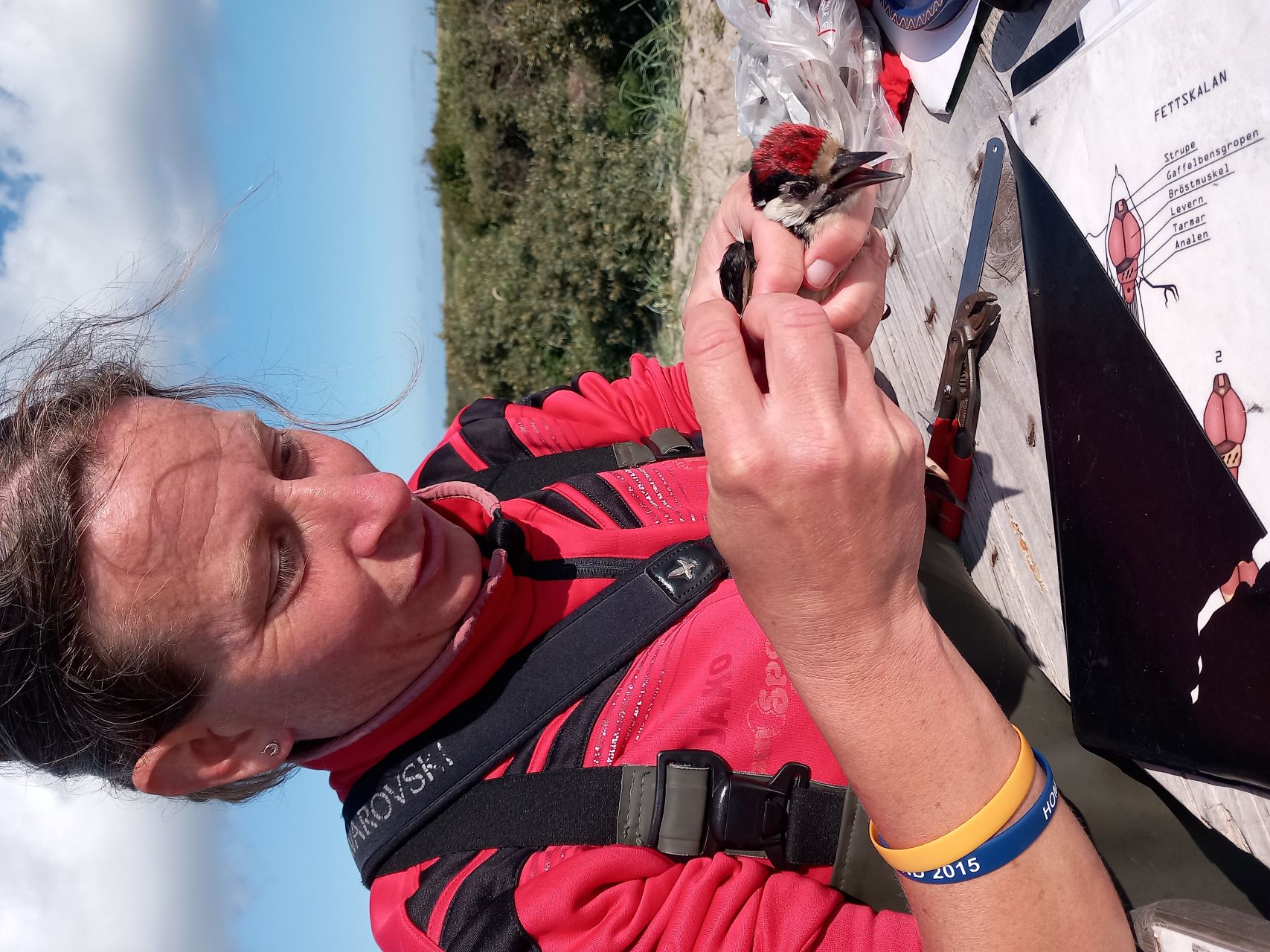
We did catch a greater spotted woodpecker (Stor Flagspætte), which was nice, also to give Sean a bit more feisty bird to hold for a change. Also, the two crested tits (Topmejse) were very cute to see in hand – and, as I am learning from Sean – no topmejse in Ireland, nor green woodpecker, or marsh warbler. I am wondering what they do have… Not mosquitos, anyway, as I am told, but I think I’d rather put up with some mosquitos if I get birds in return.
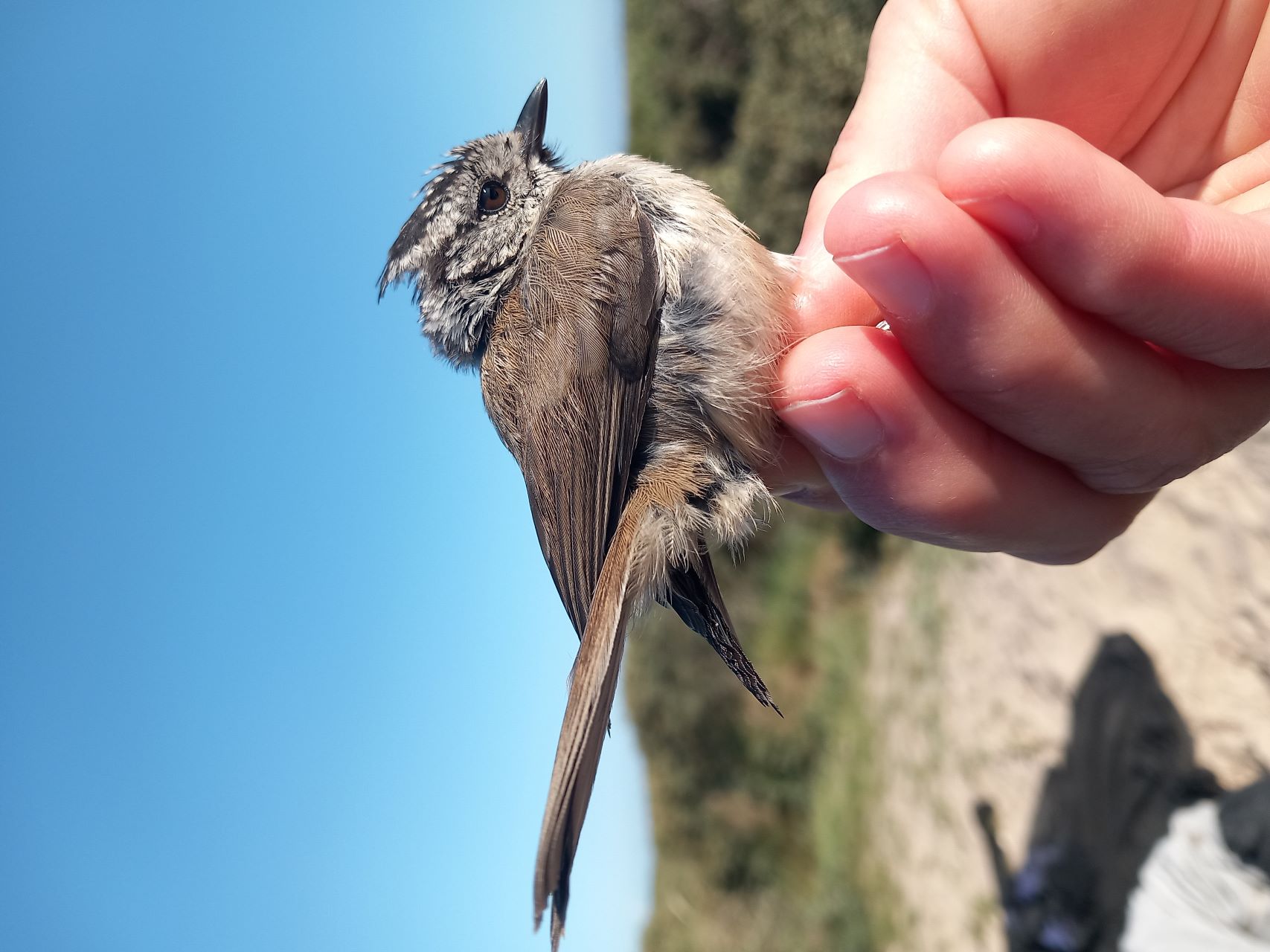
We did some net fixing after we finished the ringing, so all in all it was a very long day again for Sean and me out at Kabeltromlen. With less wind today, it was much warmer, which was not necessarily an advantage seeing that the mosquitos make it rather necessary to wear long sleeves and a head cover, and we have to wear waders anyway, in order to walk through the ditches filled with water. But no complaining, it was a very nice and sunny day out this morning.
After doing the “office work” and getting a little nap, I went out to Grenen beach for the first time since I arrived, paying a visit to the terns, mostly, but also looking at other birds, sometimes, and recovering the device we had out in the hope of it getting data from any tagged terns. I did see arctic, common and sandwich terns (havterne, fjordterne og splitterne) and also a flock of 8 dunlins (almindelig ryle). When I just wanted to leave, suddenly an arctic skua (almindelig kjove) showed up right above me. It was flying around for a while, with all the gulls present very angry and moving to a different roosting site. Then, it also tried (unsuccessfully, luckily) to hunt terns. Finally, it picked up half a fish that one of the gulls must have left, swallowed it, and went to roost in the seas just 20 meters offshore from Grenen beach.
Simon is back tonight to give a night tour of Grenen, which will probably be quite wet, therefore having good conditions for amphibians, but the rain will stop us from ringing tomorrow morning. Instead, we can either sleep in or go out on a wet migration count. We will decide on the spot and depending on weather which option we will take.
Ringing (Kabeltromlekrattet)
Stor Flagspæette (Great Spotted Woodpecker) - 1
Solsort (Blackbird) - 1
Munk (Blackcap) - 2
Tornsanger (Common Whitethroat) - 7
Gærdesanger (Lesser Whitethroat) - 1
Rørsanger (Reed Warbler) - 1
Kæersanger (Marsh Warbler) - 1
Gulbug (Icterine Warbler) - 1
Gransanger (Chiffchaff) - 7
Topmejse (Crested Tit) -2
Grønsisken (Siskin) – 3
Rørspruv (Reed Bunting) - 2
Total: 30
People: Seán Walsh, Martina Hillbrand, Knud Pedersen, Simon S. Christiansen
A link to today's observations from volunteers and local observers.
Joyful last day
Today was my last day at the station. It began at 2:40 am when me, Sean and Martina woke up to go ringing at Kabeltromlen. We put on our waders and left the station to bike to the site at 3:30 am. We got there around 3:45 am and started opening the nets around the site. We made rounds around the nets every 30 minutes to collect the birds. After bringing them back, Sean and Martina measured, sexed, aged and ringed the birds, while I took notes. We caught and ringed many Tornsanger (common whitethroat), Gærdesanger (lesser whitethroat), Gransanger (common chiffchaff), and also some Solsort (blackbird), Munk (eurasian blackcap), Blåmejse (blue tit), Grønsisken (siskin), Rørspurv (reed bunting) and a single Gulbug (icterine warbler)!
Icterine warbler. Photo by: Sean Walsh
There was also a very interesting recapture made today. We caught a Rørsanger (reed warbler), which came all the way from Norway!
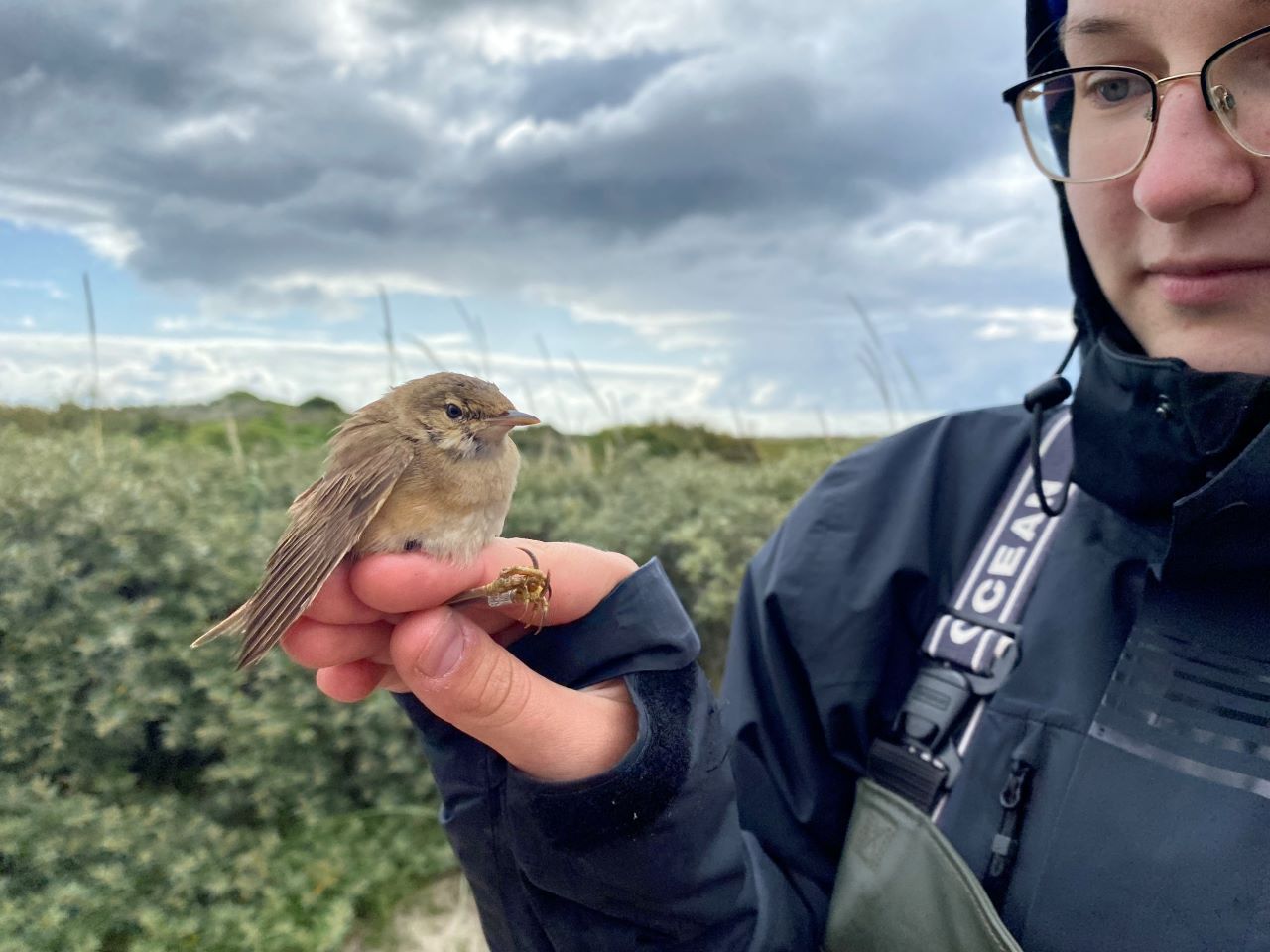
Reed warbler. Photo by: Martina Hillbrand
Around 9 am, Sean heard the Cistussanger (zitting cisticola) at the site, near the nets. We hoped to catch it and ring it, but were unfortunately unlucky. Many local birders also came to the site to watch out for the cisticola and Mark, Malthe and Lærkebjørn also accompanied us for most of the morning.
All ringing participants. Photo by: Mark Desholm
After the ringing, we came home to eat breakfast, take a nap and input our data. Afterwards, we cleaned the apartment.
Lærkebjørn who had been filming during her last stay at the guest apartment finished compiling her video about bird ringing and showed it to a fair crowd in the birder's club. It was great to get the view from an outsider about our activities here.
Martina then went back out to Kabeltromlen to cut the hedges, I started packing, and Sean cooked dinner. In the evening, we all ate together and said our goodbyes as me and Mark and his children are all departing tomorrow.
Ringing (Kabeltromlekrattet)
Solsort (Blackbird) - 2
Munk (Blackcap) - 3
Tornsanger (Common Whitethroat) - 11
Gærdesanger (Lesser Whitethroat) - 5
Rørsanger (Reed Warbler) - 1
Gulbug (Icterine Warbler) - 1
Gransanger (Chiffchaff) - 4
Blåmejse (Blue Tit) - 2
Rørspruv (Reed Bunting) - 1
Total: 31
People: Seán Walsh, Kalina Siwek, Martina Hillbrand, Knud Pedersen, Simon S. Christiansen, Mark & his children.
A link to today's observations from volunteers and local observers.
